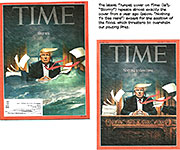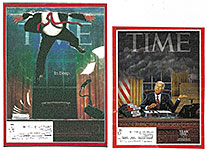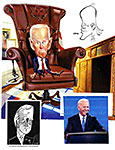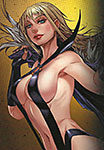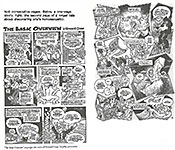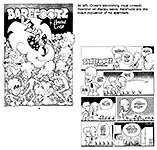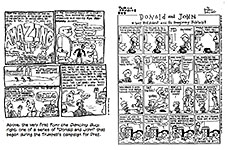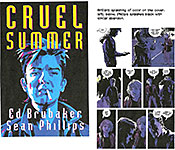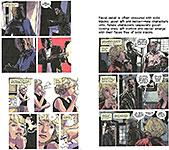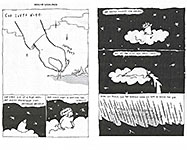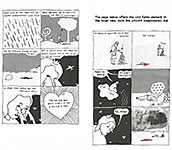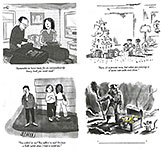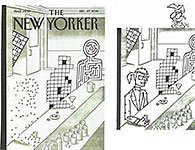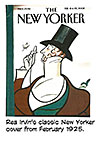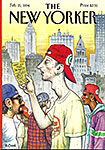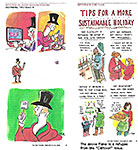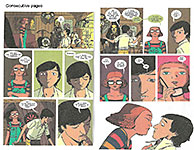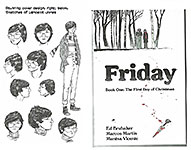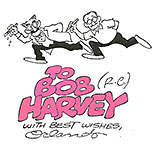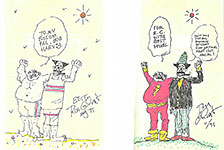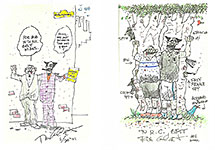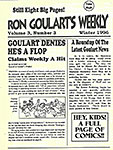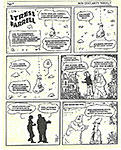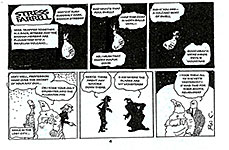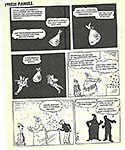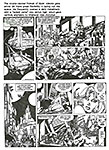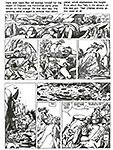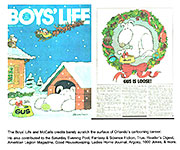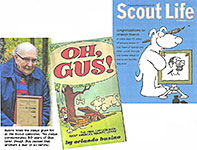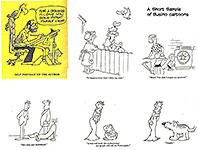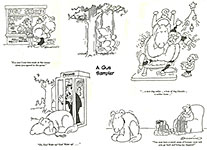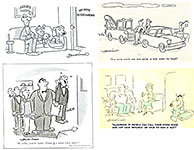 |
||||||||||||||||||||||||||||||||||||||||||||||||||
Opus 425 (February15, 2022): We report on book bannings in schools nationwide (starting with the Pulitzer-winning Maus) and review the final book in the Complete Peanuts series (which covers miscellaneous Schulz cartoons) and The New Yorker’s cartooning failures and a long farewell to Ron Goulart, plus the usual book and comicbook Number Ones reviews. In order to assist you in wading through all this plethora, we’re listing Opus 425's contents below so you can pick and choose which items you want to spend time on. An asterisk* marks the longest items. Here’s what’s here, by department, in order, beginning with the news of the day—:
NOUS R US The Summer’s Superhero Movies Black Comics Festival All Virual Another Staff Editoonist Disappears The One That Got Away Geppi’s Diamond At Its Sparkling 40th Minnie Gets Pants ODDS & ADDENDA
**PULITZER WINNING GRAPHIC NOVEL IS BANNED Editoonist Outraged Novel Supported Other Bannings of Graphic Novels and Comics
FUNNYBOOK FAN FARE Regarding the Matter of Oswald’s Body She-Hulk No.1
EDITOONERY GasBag Legions: An Essay Then, Short Sample of the Month’s Editoons
Year’s Top Toons *Ann Telnaes Daryl Cagle
RANCID RAVES GALLERY Time Covers of the Prez Caricatures of the Prez Pin-Ups from the Previews Catalog
BOOK MARQUEE The Life and Comics of Howard Cruse Tom the Dancing Bug Without the Bad Ones
BOOK REVIEWS *The Complete Peanuts: Comics and Stories, 1950-2000
*BOTTOM LINERS The New Yorker’s Christmas/Cartoon Issue Plus, the Anniversary Issue
LONG FORM PAGINATED CARTOON STRIPS Friday, Book One: The First Day of Christmas
PASSIN’ THROUGH **Ron Goulart *Orlando Busino Sidney Poitier James Bond
And More Yet on Ron Goulart
QUOTE OF THE MONTH If Not of A Lifetime “Goddamn it, you’ve got to be kind.”—Kurt Vonnegut Our Motto: It takes all kinds. Live and let live. Wear glasses if you need ’em.
But it’s hard to live by this axiom in the Age of Tea Baggers, so we’ve added another motto: Seven days without comics makes one weak. (You can’t have too many mottos.)
And in the same spirit, here’s—: Chatter matters, so let’s keep talking about comics. AND— “If we can imagine a better world, then we can make a better world.”
And our customary reminder: don’t forget to activate the “Bathroom Button” by clicking on the “print friendly version” so you can print off a copy of just this installment for reading later, at your leisure while enthroned. Without further adieu, then, here we go—:
NOUS R US Some of All the News That Gives Us Fits
THE SUMMER’S SUPERHERO MOVIES Mark Meszoros at the Ohio News-Herald starts off his review with this: “So — you’re, um, not tired of superhero movies yet, are you? No? Phew. This could have been awkward. For what feels roughly like the thousandth year in a row, other-worldly beings are at the heart of many of the most noteworthy of the releases of the next 350-plus days.” Right. It looks like the spandex crowd has taken over the motion picture industry. Here are 10 of the species you can expect to see over the next few months. ◆ “The Batman” in March with Robert Pattinson as Bruce Wayne et al. “Something delightfully—and dirtily—distinct.” ◆ “Morbius” (April) from the Marvel Comics Universe, “vampiric ramifications.” ◆ “Doctor Strange in the Multiverse of Madness” (May) with Benedict Cumberbatch as the doctor. ◆ “DC League of Super Pets” (May) animated animals. ◆ “Thor: Love and Thunder” (July) into which Christian Bale drops as Gorr the Butcher, “who certainly sounds like someone who will be a thorn in Thor’s side.” ◆ “Black Adam” (July) Dwayne Johnson as the antiheroic thorn in Captain Marvel’s side. Well, in the old comicbooks anyhow; dunno about this. But I was always thrilled when he showed up to rattle Captain Marvel’s cage. ◆ “Spider-Man: Across the Spider-Verse (Part One)” (October) wherein the success of “Spider-Man: Into the Spider-Verse” calls forth a two-part sequel. ◆ “The Flash” (November) into which Michael Keaton insinuates himself as Bruce Wayne/Batman; Ezra Miller is Barry Allen/The Flash. ◆ “Black Panther: Wakanda Forever” (November) Disney/Marvel Studios apparently chose against re-casting the title role. So it’s a movie about Black Panther without Black Panther? ◆ “Aquaman and the Lost Kingdom” (December) will doubtless find the Lost Kingdom in the ocean depths. I never liked Aquaman much back in the day; but DC has improved him.
BLACK COMICS FESTIVAL ALL VIRUAL The Schomburg Center Black Comic Book Festival has for a decade brought together animators, Blerds, bloggers, cosplay lovers, fans, families, illustrators, independent publishers, and writers to celebrate Black comicbooks and graphic novels, and it provides a platform to get the works directly to readers. This annual event features panel discussions, workshops, cosplay showcases, and highlights the work of creators from across the country. The tenth annual festival was January 13-15 and was an all virtual event due to the continuing threat of COVID. Patrons could register for events and panels online. The exhibition, “Boundless: 10 Years of Seeding Black Comic Futures,” will be on display at the Schomburg Center, 515 Malcolm X Blvd, New York, NY starting January 14, 2022.
ANOTHER STAFF EDITOONIST DROPS OUT Editorial cartoonist Mike Thompson has taken (what D.D. Degg interprets as) a buyout offer from Detroit Free Press/USA Today /Gannett. At his dailycartoonist.com, Degg quotes Thompson’s Facebook page: “After
35 years as a staff editorial cartoonist, I’m getting out on the top floor. USA Today has eliminated my editorial cartooning position and giving
me a very nice parting gift, so for the immediate future I’ll be focusing on
the comic strip, Grand Avenue, that I’ve been producing for years. I’ve
spent the last two weeks at USA Today finishing up projects and entering
contests in anticipation of a month-long break.” Thompson will eventually return to editooning but on a freelance basis. “Mike expands on his departure from staff,” Degg says, again quoting Thompson: “This is not disagreeable to me. I’ve been doing two jobs for a decade-and-a-half and will now be doing one. When you’re approaching 60, that’s a life-saver. And I will get to create work, on a freelance … good income base. None of this would be possible if I weren’t married to someone with who earns more and has better insurance. (Thanks, Hon!) The timing of all this works well with where we are in life.” “If my reckoning is correct,” Degg said, “this leaves Andy Marlette as the only staff cartoonist on a Gannett newspaper. Mike will continue to have a daily deadline for his Grand Avenue comic strip.” Grand Avenue was launched in 1999 by another editoonist, Steve Breen, a two-time Pulitzer-winner. The strip, which was at one time syndicated to about 100 newspapers, chronicles the lives of Kate Macfarlane and her two grandchildren, as the active and untraditional grandmother raises mischievous twins Gabby and Michael. Thompson started work on the strip in 2005, joining Breen. In April 2016, Thompson took on Grand Avenue by himself and began solo signing it. Grand Avenue avoids politics. “Steve started, and I’ve continued, the tradition of keeping it nonpolitical,” Thompson once said. “By the time I’m done drawing about politics, I’m tired of the tough topics, and there are so many other things in the world to draw about, interesting topics on the relations between humans and things that aren’t political in nature, but are funny and quirky and make for great cartoon fodder.”
Playboy Expires THE ONE THAT GOT AWAY This one slipped by us: in March 2020—two years ago!— Ben Kohn, CEO of Playboy Enterprises, announced that the Spring issue of Hugh Hefner’s notorious magazine would be the last regularly scheduled printed issue and that Playboy would now publish its content online. The decision (it sez here) to shut down the print edition was attributed in part to the COVID-19 pandemic which interfered with distribution of the magazine. That was merely the straw that broke the camel’s back. The magazine has been losing money for years, as much as $7 million/year lately. It’s about the only thing in Playboy Enterprises that doesn’t make money. And the present ownership of Playboy Enterprises expects profit; so they eliminated the most consistent money-loser in their control. And so, for all practical purposes, Playboy is over. Wouldn’t have happened—in fact, didn’t happen—while Hef was alive. We’ll review the magazine’s history and publish a gallery of its cartoons in a future Opus (No.427 most likely). Until then, you might commemorate the two-year-old disaster by reading the biography of founder Hugh Hefner at Harv’s Hindsight for October 2017; or visit Opus 349 for a review of the “no nudes” fiasco a couple years back; or go back to Hindsight, this time for November 2003, and read about Jack Cole, whose water-colored cartoons set the bar for Playboy cartoonists.
GEPPI’S DIAMOND AT ITS SPARKLING 40TH Diamond Comics Distributors celebrated its 40th anniversary on February 1, and Heidi MacDonald took notice at comicsbeat.com. ... “Love ’em or hate ’em, founder Steve Geppi is one of the most colorful and key figures of the era, and Diamond is one of the most important companies in comics history – and I can’t think of another business where common fans keep up on the inner workings of a primary distributor. That’s the way the community of comics works. “It’s been an up-and-down few years for Diamond, but they’re still here and say what you will about the company, Diamond does care a lot about comics and the people who make and sell them. I know that from my own decades talking to the hard working men and women who run the company. So on this day, I wish them a hearty Happy Birthday.” Heidi then quotes part of the Diamond press release, and we’re quoting even less but with our congratulations still: “On February 1st of 1982, President and CEO, Steve Geppi, transitioned from local retailer to comic book distributor with one warehouse and seventeen customers. Forty years later, Diamond has grown into the largest distributor of English-language comic books, graphic novels, and related pop culture merchandise worldwide.”
MINNIE GETS PANTS Minnie Mouse will be sporting a blue pantsuit to celebrate Women’s History Month and Disneyland Paris’ 30th anniversary. Originally the pantsuit helped women blend into male-dominated spaces, says Kim Elsesser, who covers the intersection of business, psychology and gender for Forbes, “but the pantsuit has now become a symbol for women’s empowerment.” For the 30th Anniversary of Disneyland Paris, British designer Stella McCartney created Minnie’s first pantsuit which will be worn at the Paris theme park. Said McCartney: “I
wanted Minnie to wear her very first pantsuit at Disneyland Paris, so I have
designed one of my iconic costumes, a blue tuxedo, using responsibly sourced
fabrics. This new take on her signature polka dots makes Minnie Mouse a symbol
of progress for a new generation. She will wear it in honor of Women’s History
Month, in March 2022.” I’m glad the fabrics are responsibly sourced. Then Elsesser rushes in with a short history of power symbols. “For centuries, the suit has been a symbol of male power. A few women in elite circles in the 1930s began wearing pantsuits (think Greta Garbo and Marlene Dietrich), but until the 1950s women could be arrested for wearing pantsuits for ‘impersonating a man.’ By the 1960s, pantsuits had a slightly broader appeal, but it wasn’t until 1993 that women were even allowed to wear pants on the U.S. Senate floor. Carol Moseley-Braun and Barbara Mikulski were the first women to break with this tradition: they wore pantsuits on the Senate floor and got the dress code changed.” Elsesser goes on: “Hillary Clinton’s pantsuits became famous after her historic run for the presidency. In her book, What Happened, she describes why the pantsuit was her outfit of choice. ‘They make me feel professional,’ she writes, adding she also felt the pantsuit helped her fit in with the other male politicians.” No, not “other male politicians”; that would mean Hillary is also male. Geez. Just can’t get good help these days. Back to Minnie. It’s not clear from what Elsesser says if Minnie’s wearing of a pantsuit will happen only for the 30th anniversary of Disneyland Paris. Elsesser can give us the history of the pantsuit but can’t seem to focus on the news at hand.
ODDS & ADDENDA To celebrate the opening of the 25th season of “South Park” on February 2, creators Trey Parker and Matt Stone assembled a group of Broadway stars, along with a 30-piece orchestra, to perform the series’ classic tune “Kyle’s Mom’s a Bitch.” ... Peter Robbins, whose voice brought Charlie Brown to life in Peanuts tv shows in the 1960s but who struggled with mental illness and served prison time later in his life, died January 18.
SCHOOL BOARD BANS PRIZE-WINNING GRAPHIC NOVEL And That’s Just the Tip of the Iceberger A Tennessee school board barred schools from teaching Maus, a Pulitzer Prize-winning graphic novel about the Holocaust, in an unanimous vote that was taken, ironically, on the day before Holocaust Remembrance Day. Officials objected to eight instances of profanity, “Goddamn,” and a drawing of a naked female, reported Blake Montgomery at dailybeast. com. Members of the McMinn County school board said the ban was not related to the book’s depiction of the Holocaust as it tells the story of author Art Spiegelman’s parents in German concentration camps, with Jews depicted as mice and Nazis as cats. The female nude was, therefore, a naked cartoon mouse—but, admittedly, with a human body. Spiegelman, asked about the ban, said he was “baffled” by it, calling the school board’s decision “Orwellian.” “It’s leaving me with my jaw open, like, What?” he said. In the current sociopolitical climate, he views the Tennessee vote as no anomaly. “It’s part of a continuum, and just a harbinger of things to come,” Spiegelman told Michael Cavna at the Washington Post, adding that “the control of people’s thoughts is essential to all of this.” As
such school votes strategically aim to limit “what people can learn, what they
can understand and think about,” he says, there is “at least one part of our
political spectrum that seems to be very enthusiastic about” banning books. “This is a red alert. It’s not just: ‘How dare they deny the Holocaust?’ ” he says with a mock gasp. “They’ll deny anything.” The decision, says reporter Montgomery, comes as conservative officials across the country increasingly have tried to limit the type of books that children are exposed to, including books that address structural racism and LGBTQ issues. Board member Tony Allman is quoted by the Associated Press: “It shows people hanging. It shows them killing kids. Why does the educational system promote this kind of stuff? It is not wise or healthy.” Jeet Heer at jeetheer.substack.com quotes another board member, Mike Cochran, as saying: “I thought the end was stupid to be honest with you. A lot of the cussing had to do with the son cussing out the father, so I don’t really know how that teaches our kids any kind of ethical stuff. It’s just the opposite, instead of treating his father with some kind of respect, he treated his father like he was the victim.” The scene Cochran is describing is from the end of the first volume of Maus, where Spiegelman learns that his father had destroyed his late mother’s diaries. Those diaries are important for many reasons, not least because Spiegelman’s mom committed suicide and the diaries might provide clues as to the experiences that led to that tragedy. Art is enraged and fights with his father, saying, “God damn you!” Art yells. “You – you murderer! How the hell could you do such a thing!!” This is no doubt a harsh scene, Heer says. “It’s also one of the crucial moments in the book, because it shows how the Holocaust shaped the Spiegelman family long after it was over, leaving them with all sorts of unprocessed traumas and fights over memory. To have a scene where the son was dutifully respectful of the father at all times would have been a lie and it would also have destroyed the human meaning of the book, the honesty that made it speak to so many readers.” The board members spent a lot of time talking about what they call the “nude scene.” Tony Allmann in particular is hung up on the fact that Spiegelman once, in the late 1970s, drew cartoons for Playboy: “I may be wrong, but this guy that created the artwork used to do the graphics for Playboy,” Allman says. “You can look at his history, and we’re letting him do graphics in books for students in elementary school. If I had a child in the eighth grade, this ain’t happening. If I had to move him out and homeschool him or put him somewhere else, this is not happening.” Says Heer: “It’s hard not to escape the suspicion that Allman is conflating graphic novel with the phrase ‘graphic sex.’ “This all puzzled me because I didn’t remember anything salacious in Maus at all. New York Times reporter Joan Coaston solved the mystery by noting that the ‘nudity’ in Maus is a scene were the prisoners in Auschwitz are stripped naked and beaten.” And they’re all mice, remember. The U.S. Holocaust Museum tweeted that “Maus has played a vital role in educating about the Holocaust through sharing detailed and personal experiences of victims and survivors. Teaching about the Holocaust using books like Maus can inspire students to think critically about the past and their own roles and responsibilities today.” Randi Weingarten, president of the American Federation of Teachers, said: “Yes, it is uncomfortable to talk about genocide, but it is our history and educating about it helps us not repeat this horror.” Spiegelman has been approached at least four separate times over the years to turn Maus into a movie, but has flatly refused. “I like movies, but Maus is better served as a book,” Spiegelman says. “[It’s a] more intimate form and comics adhere to the brain better.” He
has also turned down millions of dollars in licensing and merchandising deals
relating to Maus iconography. The Complete Maus, which is a two volume production, reached the top position on Amazon’s best-seller list Monday, January 31st. A discussion of the Maus banning on tv’s “The View” also led ABC to suspend co-host Whoopi Goldberg for two weeks after she said the Holocaust “isn’t about race.” To Goldberg, a Black person, “race” has always to do with skin color. Later, she realized that not everyone thinks of “race” that way. “I get it,” she said, and she apologized. At The Comics Journal website, tcj.com, you can find the transcript of the discussion at the McMinn school board meeting that resulted in Maus being banned. Reading it is an education in how simple-minded some of our good citizens are. It’ll make you blink. Here’s the link— https://www.tcj.com/transcript-of-the-mcminn-county-board-of-educations-removal-of-maus/ Editoonist Outraged Over Maus Banning
Maus is a graphic novel by Art Spiegelman about the Holocaust. It’s very dark and disturbing, you know, because it’s about the Holocaust. A proxy for the author is a mouse who interviews his mouse father about his experience in the Holocaust. The Nazis are depicted as cats. The McMinn County School board in Tennessee has pulled the book from the eighth-grade curriculum because they believe either eighth-graders are too young to learn about the Holocaust or they want to protect Nazis because 60 percent of the country are Trumpers, or they’re all cat people. Trip advisors advise that the National Holocaust Museum in Washington, D.C. is fine for 12-year-olds, though there are parts of the museum that has been determined safe for ages as young as eight. I think kids in the eighth grade would be fine with learning about the Holocaust from Maus. In fact, I think that’s an excellent way to start being educated on the subject. Besides, kids in the eighth grade have the Internet. They all have smartphones. Okay, maybe not in Hooterville, Tennessee, but I bet they at least have Animal Planet and they’ve seen how giraffes jump on top of each other. I bet half of them have seen “Inglourious Basterds.” If they can handle giraffe sex and Brad Pitt bashing Nazis’ brains in with baseball bats, then they can handle Maus. Can the school board in Tennessee at least appreciate the irony of banning books about people who banned books? Hello? Is anyone home? The Tennessee troglodytes aren’t the only thuglicans running amuck. Neil Young has been standing on his principles for decades, long before Joe Rogan realized he could turn a failed acting career into a successful racist conspiracy-theory-spreading podcast career. And now, the troglodytes have canceled Neil Young in favor of Joe Rogan. Many years ago, Mr. Young wrote a song called “Southern Man” which covered racism in the southern United States. The song was so strong that it pissed off Lynyrd Skynyrd who wrote the greatest answer song in music history, “Sweet Home, Alabama.” Funny enough, there was never a feud between Young and Skynyrd. They had fun taking shots at each other but were actually friends and fans of each others’ music. Lynyrd Skynyrd defended the south, but also wrote their share of anti-racism songs, and at least one anti-gun song. I digress. The point is, Neil Young has principles. Now, Spotify is singing it doesn’t need Mr. Young around anyhow because Old Neil put her down. Neil Young demanded that Spotify remove his music from their service unless they removed Joe Rogan’s racist and ignorant podcast, which Spotify had just signed to an exclusive multi-gazongo million-dollar deal. Rogan’s podcast is wildly popular and might be the number-one podcast in the nation, and in close competition with Steve Bannon’s among racists. Neil Young has written great music for decades and has influenced bands like Pearl Jam, but it’s not like the kids are buying his albums anymore. C’mon, he’s 76. So, guess which one Spotify picked. Despite moving poisonous content from its platform in the past, Spotify chose to stick with Rogan and his racist conspiracy theories. Did you catch the show earlier this week when white Joe Rogan led a rant explaining what does and does not define a Black person? According to Rogan, they can only come from the “deepest and darkest” places of Africa. But yeah, Spotify kicked Mr. Young to the curb. But so what? Give us some more of those Rogan explanations why African Americans aren’t black people, Spotify. That’s good stuff (this is heavy sarcasm, slow kids). Of course, all the cancel-culture whining mofos are in euphoria over this. They’re still pissed off at Mr. Young for denigrating racists in “Southern Man.” I’m a casual fan of Neil Young’s music. I’m a bigger fan of the person he is. I was in a band once that played a pretty good version of “Down by the River” and I was in another band that played a crappy version of “Rocking in the Free World.” I love a lot of his music, most of all, “Harvest Moon,” which I covered all by myself on acoustic guitar. Neil Young kicks ass. I just realized that I’m not a casual fan of his music. I’m a huge fan. And being a sloppy guitar player, I should be. Neil Young has what we’re lacking in this nation. Principles, ethics, and dignity. He stood his ground and lost money. Spotify traded in its principles for profit and in the process, contributed so much ignorance and poison to the nation. And who said the Swedes can’t be capitalists? Ban books? We need to bring in more books that are disturbing and educational. We need more education, not less. There are too many Joe Rogans out there and not enough Neil Youngs. Hey, have the Tennessee goons banned Neil Young’s “Southern Man” yet? I hope Spotify will remember that a cartoonist man don’t need them around anyhow.
Signed Prints. Clay Jones is selling signed prints of his cartoon at the top of this article for just $40.00 each at his website, claytoonz.com Every cartoon on this site is available. You can pay through PayPal. If you don’t like PayPal, you can snail mail it to Clay Jones, P.O. Box 3721, Fredericksburg, VA 22402. Clay says he can mail the prints directly to you or if you’re purchasing as a gift, directly to the person you’re gifting.
COMICBOOK STORE GIVES AWAY MAUS In reaction to the McMinn County school board banning, a Knoxville comicbook store announced on Thursday, January 27, that it would begin giving away free copies of Maus for students who want to learn more about the Holocaust. The WBIR staff reported that Nirvana Comics owners said they would give away copies of the book because they "believe it is a must-read for everyone." They said all students need to do is ask for a copy by calling them or reaching out on social media. However, they said they had a limited supply of books so there could be a waitlist for anyone interested in reading it. They said they had a large order of Maus expected to arrive soon, so they could give away more copies of the book after their initial supply was loaned out or sold. "We are in discussions with a much larger organization to expand the program. We hope to have news on that soon," they also said. Anyone who wants to help with Nirvana Comics' program can also donate. They said they are looking into crowdfunding platforms to better organize donations. On Friday, they launched a campaign on GoFundMe. Nirvana Comics can be reached at 865-200-5067 or online. And other responses to the Maus banning prompts good news—; Rich Johnston at bleedingcool.com reports that a live reading of Maus followed by a conversation about the book and its subject was scheduled for February 3 at St. Paul’s Episcopal Church in downtown Athens in McMinn County, thumbing its nose at the action of the McMinn school board. All the publicity about the banning has sparked sales of the book, Johnston says. Forty-two years after it was first released, Maus is currently the twelfth best-selling graphic novel on Amazon.com for Book One, and 13th for the Complete Maus.
FLORIDA CONSIDERS BANNING BESTSELLERS Polk County in Florida is the latest to be subject to banning of the critically acclaimed bestselling graphic novels from schools, part of a series of such exclusions in recent years that Bleeding Cool has covered. At bleedingcool.com, Rich Johnston reports that Polk County Public Schools Superintendent Frederick Heid has asked middle and high school librarians to remove 16 books from schools for a review, after receiving complaints about the books from the activist group County Citizens Defending Freedom. Among the withdrawn books is Drama by Raina Telgemeier, one of the bestselling graphic novels of recent times, from 35 locations. The graphic novel is a coming-of-age story involving the crew of a middle school musical that has won both praise and criticism for its LGBTQ portrayal. But the affected books are not banned: they are being reviewed in response to complaints and may, eventually, be banned. Or cleared and put back in circulation again. County Citizens Defending Freedom describes itself as "an organization that empowers and equips American citizens to defend their freedoms and liberties at the local level. By streamlining and simplifying activism, we support and champion American citizens who want to stand up for their independence. To equip and empower American citizens to stand for and preserve freedom for themselves and future generations. To resolve breaches of freedom and liberty through local awareness, local light, and local action." And a vision to "see CCDF-USA affiliates spread organically in counties across America. To become the inspiration and action arm of local citizens to defend their faith, freedom, and liberty, while placing local governance under the watchful eye of local American citizens acting as patriots." In this case, says Johnston, that means fighting for the freedom to pull books from school shelves and against the freedom for kids to read them. And by pure coincidence, the sixteen titles named include gay themes like Drama or tackle racism. Superintendent Heid told LKLD Now that the group's members allege the books contain material harmful to minors which would violate Florida statute 847.012, which involves distribution of "harmful materials" to minors. "While it is not the role of my office to approve/evaluate instructional or resource materials at that level,” said Heid, “I do have an obligation to review any allegation that a crime is being or has been committed. It is also my obligation to provide safeguards to protect our employees." The named books are—:
Drama by Raina Telgemeir Thirteen Reasons Why by Jay Asher The Bluest Eye by Toni Morrison The Kite Runner by Khaled Hossein Beloved by Toni Morrison Two Boys Kissing by David Levithan Extremely Loud and Incredibly Close by Jonathan Safran Foer The Vincent Boys by Abbi Glines It's Perfectly Normal by Robert Harris, illustrated by Michael Emberley Real Live Boyfriends by E. Lockhart George by Alex Gino I am Jazz by Jessica Herthel and Jazz Jennings Nineteen Minutes by Jodi Picoult More Happy Than Not by Adam Silvera Tricks by Ellen Hopkins Almost Perfect by Brian Katcher
NATION-WIDE EFFORTS TO BAN BOOKS By Elizabeth A. Harris and Alexandra Alter at the New York Times In Wyoming, a county prosecutor’s office is considering charges against library employees for stocking books like Sex Is a Funny Word and This Book is Gay. In Oklahoma, the state Senate is considering a bill that would prohibit public school libraries from keeping books on hand that focus on sexual activity, sexual or gender identity. Parents, activists, school board officials and lawmakers around the country are challenging books at a pace not seen in decades. The American Library Association said in a preliminary report that it received last fall an “unprecedented” 330 reports of book challenges, each of which can include several books. But it’s not just the frequency of such challenges. Fueled by social media and a national divisiveness, conservative groups are now pushing their challenges into statehouses, law enforcement and political races. “The politicalization of the topic is what’s different than what I’ve seen in the past, “ said Britten Follett, chief executive of content at Follett School Solutions, one of the country’s largest providers of books to K-12 schools. The most frequent targets are books about race, gender and sexuality, “including oral sex and anal sex, and,” says the founder of Moms for Liberty, “— children are not ready for that kind of material.” Parents, she goes on, should not be vilified for questioning the appropriateness of a book—without considering the book. George M. Johnson, author of All Boys Aren’t Blue, a memoir about growing up Black and queer, was stunned in November to learn that a school board member in Florida and filed with the sheriff’s department a complaint against his book. “I didn’t know that was something you could do—file a criminal complaint against a book,” Johnson said. So far, efforts to bring criminal charges against librarians and educators have largely faltered. And courts have generally taken the position that libraries should not remove books from circulation. But the fussin’ goes on.
THE ADVOCACY GROUP NO LEFT TURN IN EDUCATION maintains list of books it says are “used to spread radical and racist ideologies to students.” Some groups say prohibiting books violates the rights of parents and the rights of children who believe access to books is important. Book challenges aren’t coming just from the right: Of Mice and Men and To Kill a Mockingbird, for example, have been challenged over the years for how they address race, and both were among the Library Association’s 10 most-challenged books in 2020. A school district in Washington state voted last month, at the request of staff members, to remove from the ninth-grade curriculum To Kill a Mockingbird—voted the best book of the past 125 years in a survey of readers conducted by the New York Times Book Review. Objections to the book included arguments that it marginalized characters of color, celebrated “white saviorhood” and used racial slurs dozens of times without addressing their derogatory nature. Politicians on the right have seized upon the controversies over books, exploiting them for political advantage. The newly elected governor of Virginia, a Republican, rallied supporters by framing book bans as an issue of parental control. In Texas, Governor Greg Abbott demanded that the state’s education agency “investigate any criminal activity in our public schools involving the availability of pornography,” a move that might make librarians fear might make them targets of criminal complaints. The governor of South Carolina asked the state superintendent to investigate the presence of “obscene and pornographic” materials in its public schools, offering Gender Queer as an example of a questionable book. The mayor of Ridgeland, Mississippi recently withheld funding from the school library system, saying he would not release the money until books with LGBTQ themes were removed. At The Week, we learned last year that when Dr. Seuss’ publisher stopped printing one of his older books because of its racial stereotypes, Fox News and Republicons cried “cancel culture!” But unashamed of their hypocrisy, conservatives in 30 states are now seeking to root out books from classrooms and school libraries that offend them “in what experts are calling a historic and concerted book-banning effort.” ... GOP activists, school boards, lawmakers, and governors across the nation quickly got in on the action, issuing orders and crafting legislation to protect kids from books that discuss racism, sexuality, feminism, and other “dangerous” topics. The ongoing “frenzy” of right-wing censorship is the largest since the 1920s campaign against teaching evolution. ... In Texas, GOP state Representative Matt Krause is investigating a list of 850 books for their potential to cause “discomfort.” ... Parents are objecting to their kids being taught that biological sex is an illusion, that America is inherently racist, that “whiteness” is evil, and the other far-left tenets of “critical race theory.” ... And over time, both the Left and Right have sought to remove novels and texts for ideological reasons. ... In the New York Times, Viet Thanh Nguyen said it’s the potential of books to be “dangerous”—to our preconceptions, our complacency, our circumscribed empathy—that makes them so vital. A society that starts banning books to avoid discomfort is headed “to the wrong destination.”
Fascinating Footnit. Much of the news retailed in the foregoing segment is culled from articles indexed at https://www.facebook.com/comicsresearchbibliography/, and eventually compiled into the Comics Research Bibliography, by Michael Rhode, who covers comic books, comic strips, animation, caricature, cartoons, bandes dessinees and related topics. It also provides links to numerous other sites that delve deeply into cartooning topics. For even more comics news, consult these three other sites: Mark Evanier’s povonline.com, Alan Gardner’s DailyCartoonist.com (now operated without Gardner by AndrewsMcMeel, D.D. Degg, editor); and Michael Cavna at voices.washingtonpost.com./comic-riffs . For delving into the history of our beloved medium, you can’t go wrong by visiting Allan Holtz’s strippersguide.blogspot.com, where Allan regularly posts rare findings from his forays into the vast reaches of newspaper microfilm files hither and yon.
FURTHER ADO Like a velvet glove cast in iron—the name of a graphic novel by Dan Clowes. I just like the imagey. The thing about peeling an orange is that it postpones gratification. Eventually, you grow to like peeling better than eating, at which point, we may say the orange has won.
FUNNYBOOK FAN FARE Four-color Frolics An admirable first issue must, above all else, contain such matter as will compel a reader to buy the second issue. At the same time, while provoking curiosity through mysteriousness, a good first issue must avoid being so mysterious as to be cryptic or incomprehensible. And, thirdly, it should introduce the title’s principals, preferably in a way that makes us care about them. Fourth, a first issue should include a complete “episode”—that is, something should happen, a crisis of some kind, which is resolved by the end of the issue, without, at the same time, detracting from the cliffhanger aspect of the effort that will compel us to buy the next issue. A completed episode displays decisive action or attitude, telling us that the book’s creators can manage their medium.
BECAUSE I DON’T LIKE TO LEAP to conclusions, I have refrained from telling myself that Oswald’s body in Regarding the Matter of Oswald’s Body is the body of Lee Harvey Oswald, killer of Prez John F. Kennedy on November 22, 1963. But by the end of the first issue, it’s clear that the Oswald at issue is indeed the Lee Harvey one. Not that there aren’t plenty of hints long before we get to the end. I just don’t like leaping, as I said. The book opens with page of text on Doppelgangers or Doubles. Then we have some sort of organization chart, littered with cross-outs except for the names Jack Ruby and Lee Oswald, the latter name connected to the word “decoy.” On the next page, the visuals begin with a picture of a decaying body in a coffin. Several people are digging up a grave and removing the body to take it somewhere to confirm or deny a rumor that the body isn’t “him.” To leap, finally, to some conclusions that aren’t yet apparent, presumably “he” is Oswald, murderer of JFK, and there’d been a body switch: Oswald was never dead. Then
we watch a miserably unsuccessful ($81) bank robbery on November 8, 1963. The
robber is disappointed to learn his robbery hasn’t made it into the news of the
day. He goes to his motel, and when he goes to bed, his slumber is distrubed by
the arrival of Frank, a big guy, who barges into his room and offers Shep (the
robber) a job. Next we meet Buck Willy, a troubadour in a bar about to sing but he’s boo’d offstage. Outside in the parking lot, Frank shows up and offers Buck a job. Also November 8, 1963. Then, still 1963, we meet college-age Wainright, a failure at everything but shooting a gun, and he’s a marksman. Frank shows up and offers him a job. Then Frank gets Rose out of jail; then he takes her to meet the rest of his gang. They’ve been selected for their individual talents: Shep, who’s good at escaping the consequences of his actions, can “get them in and out”; Buck can drive the car; Wainright has the firepower, and Rose is good at forging documents. Frank
shows them a photo of Harvey Oswald and tells them their job is to find someone
who looks like Oswald—a doppleganger. With the emergence of the photo, we
realize that this tale is about Lee Harvey Oswald. The book is a cascade of episodes—each one re-introducing Frank; and each one establishing the ability of the authors (writer Christopher Cantwell and illustrator Luca Casalanguida) to build and sustain suspense. Casalanguida’s drawing style deploys a crisp outline with lines of moderate thickness; then, as required for some scenes, he edges his pictures with chips of solid black, modeling the forms. Nice. They stage the action expertly and create visual variety by varying camera angle and distance. The second issue opens with a diagram of city streets and the floorplan of an office. (Or a warehouse?) The opening page is dated October 5, 1981 in Dallas in a hospital where people are inspecting the body we saw unearthed last time. They’re comparing it to the statistical Lee Harvey Oswald. Then we go back to November 21, 1963, and Frank’s quartet, Shep, Buck, Wainright, and Rose in a car in a parking lot outside Lovers Lane Bar, waiting for something to happen. When it does, it takes the shape of a guy being booted out of the bar. This guy, whose name is Sonny Germs, Frank tells the foursome they must kidnap—for which deed, they’ll each be paid $4K. They do it. They tie him up. He subsequently gets loose and points a shotgun at them. They all four jump on him and Buck chloroforms him into unconsciousness. They tie him up in a house and phone Frank, who tells them to let Wainright shoot the guy on the left side of the adomen right in the lower ribs —point blank —for $10K. When they find out, they’re all disturbed about it. They didn’t hire on to commit murder. A propos of nothing, we see Oswald with rifle at a window in the schoolbook building. But before anything else can happen, Germs gets loose again and runs off. Rose pursues in a car and in the ensuing action, Germs is killed when Rose accidentally runs the car into him. And at that moment, as they stare at Germs’ body, they learn JFK has been shot in downtown Dallas. There the book ends with the facing page, completely blank except for the words “Who the fuck is JD Tippit?” followed by a diagram that shows inside Dallas Police Dept, with Oswald’s route marked; ditto Jack Ruby’s route. This is enough to give you bad dreams at night.
SHE-HULK, back
in her own title, gets the cover of No.1 all to herself. And the cover, by Jen
Bartel and Adam Hughes, is the best thing about the issue, which Jen
Walters spends mostly worrying about her lack of wardrobe. Then Jen goes to a job interview with Mallory Book (former Miss Utah and “the best lawyer in New York”), who promptly hires her without even conducting an interview. Jen is now late for her meeting with Janet Van Dyne, Wasp, who offers to share her apartment with Jen and then leaves her alone to luxuriate in this fantastic apartment. Jen, delighted, flops onto a giant bean-bag chair/bed, this time, a half-page pic of her flop, another full-figure picture, as we see in the previous illustration.
Don’t return for the second issue of She-Hulk (she’s on the cover again, this time seated on the book title) unless you like full-figure pictures of green women. (Well, who doesn’t? But if it weren’t 3:30 a.m. and I can’t sleep so I may as well write something, I wouldn’t have read and reviewed this sorry specimen of a superhero comicbook—a pin-up book, really.)
QUOTES & MOTS When pondering Time magazine, I never noticed before: Time spelled backwards is Emit, perhaps a better name for a newsmagazine.
CIVILIZATION’S LAST OUTPOST One of a kind beats everything. —Dennis Miller adv. THE GASBAG LEGIONS have been tuning up all year in preparation for Joe Biden’s first year anniversary. And when it arrived, the bloviators expounded accordingly, finding the Biden presidency severely lacking in all sorts of desirable behaviors. Among the most frequently listed of Biden’s so-called “failures” is the “disastrous” withdrawal from Afghanistan, the number of illegal immigrants that streamed across the southern border into the country this year (all because of Biden's refusal to enforce our immigration laws), inflation (principal cause of which is high energy prices—the product of Biden's energy policies), restricting domestic oil and gas production, mishandling of the COVID-19 pandemic characterized by frequent policy reversals, failing to abolish student loan debt, not dropping Trump-era sanctions on Iran and re-entering the Iran deal, and failure to take significant action on climate change. All of which overlooks some of his administration’s accomplishments— ending the Afghanistan “War,” greatly minimizing the drone war, ending the Keystone XL pipelline, passing the $1.9 trillion American rescue plan, passing the $1.2 trillion infrastructure bill, and raising the pay of federal contractors to $15/hour. And the economy is booming and unemployment is at an all-time low. But presidents can’t much affect these matters—although they are blamed if something goes awry in either realm. But when the GasBags get this far in their assault on Biden, they discover something else to rail on about. Something more deliciously threatening. They’ve discovered that the United States, bastion of liberty and the celebrated home of a model democracy, is becoming more and more authoritarian—more fascist—as time wends onward. Several mobs of Concerned Citizens even claim that democracy in this country is over. It’s disappeared. Gone. Other Concerned Citizens maintain stoutly that democracy isn’t over in this country. Not yet. But it’s leaning in that direction and we must DO SOMETHING to prevent losing it altogether. Among some of the Concerned Citizens the fear that the United States is less of a democracy these days is fairly real. They’re serious about its impending loss. And they’re whipping up enthusiasm—for what? For an overthrow of the government (because it’s a fascist government)? Hard to say what Concerned Citizens are advocating for. But, alas, I’m not concerned. Much. As I said a couple months ago, democracy is best thought of as a game, like any board game in your closet. The game has rules. To play the game, you must follow the rules. When you stop following the rules, the game ceases. It cannot survive without its rules. When democracy slowly expires, there is no violence. The government does not change with a coup. It changes slowly, almost imperceptibly. Until we wake up one day and realize that some of the rules that sustained our democracy are no longer being adhered to. And so democracy ceases. No rules, no democracy. So how do we prevent the loss of democracy? Simple: just follow the rules. (Among the rules are provisions for protesting against the government—the third sentence of the Declaration of Independence, “the right of the people to alter or abolish”— so it’s not as if we become obedient sheep.) Now, to respond to the Concerned Citizens: if we were in real danger of losing our democracy, there would be more wholesale rule flouting. There would be less adherence to the rule of law and of order. People would start driving on the wrong side of the street and going to the head of lines of people who are waiting for the tally of their grocery bill. The Trumpet has been the most conspicuous example of an elected leader who simply avoids obeying the rules. Because of the enthusiasm of his most passionate followers, his growing autocracy seems powerful—and growing more powerful every day. But it isn’t. Despite the reporting of the news media, the Trumpet isn’t all-powerful. His progress towards a fascistic society has been often frustrated. By the Supreme Court. The Supremes have repeatedly ruled against some scheme or another of the Trumpet’s. And as long as the Supremes continue to uphold the rule of law as embodied in its function, the Trumpet will remain what he has always been—a loud mouth who got lucky once. And our democracy will survive. It will frustrate and defeat fascist tendencies. And the Supremes are not alone. Many other Americans feel the same way. And the news media will continue to function as a megaphone loudly voicing its objections to fascism (while at the same time, often egging on the autocrats. Go figure.) Democracy is not in as much trouble as the Concerned Citizens claim. It just makes noises like it is. And it could get that way. Nothing’s guaranteed. But at the moment, those who seek to bypass democracy because it’s so inefficient in favor of fascism because it is so much more efficient will be frustrated by various institutions in our society. Not all of them maybe. But enough. Enough to keep us afloat for a while yet. And how can we help? Easy. Just obey the rules.
TOP TOONS OF THE YEAR YEAR’S END prompts lists of the year’s accomplishments. Ann Telnaes —winner of both the NCS Reuben and the Pulitzer—produces editorial cartoons for the Washington Post, animated cartoons as well as the traditional static commentaries. Her own selection of her own year’s best (mostly in the latter mode) follows:
And then, two of Telnaes’ animated editoons. This being a static medium in front of you, you must imagine motion from the progressive movement depicted in selected moments culled from the animations— static seconds in the over-all motion of each cartoon. Enjoy.
See Opus 149 for more on Telnaes.
DARYL CAGLE operates a syndicate, CagleCartoons.com, that distributes editoons daily to about 700 of the nation’s 1,500 or so daily newspapers. Based upon popularity—how many papers used which cartoons—Cagle published at his website the Top Ten Editoons of 2021. Interestingly, none of the Top Ten used caricatures of politicians. Why not? My guess is that a caricature immediately “selects” the papers that publish it: editors that like that politician, publish the caricature; those that don’t, don’t. It depends, ultimately, upon whether the caricature depicts the politician favorably or not. Readers are likely to be upset if a favorite politician is caricatured. If you don’t publish cartoons with caricatures of politicians in them, you avoid getting your telephone switchboard jammed up with readers calling to protest. Without caricatures, the editoons will be picked and published based upon newspaper editors’ support —or lack thereof— for the issue drawn in the cartoon.
EDITOONERY The Mock in Democracy AS USUAL, I’VE RUN OFF AT THE MOUTH so much so far this opus that the only way left to reduce the bulk is to abbreviate our coverage of the month’s editorial cartoons. Herewith. (But we’ll do a Special Edition of mostly editoons in a week or so, just to catch you up.) One of the continuing top events of the month concerns the House investigation of the January 6 insurrection. (Or, as it’s known in journalismspeak, Jan6.) Did it happen as a result of the Trumpet’s urging? Or not? No sane observer believes the latter. It was Trump, no question. In
the first cartoon at the upper left, John Cole gives the “6" in
Jan6 a functioning role in a visual metaphor wherein the Grandstanding
Obstructionist Pachyderm’s share of the guilt results in his being hanged by
the 6. Next, Steve Breen gives us his opinion on the Trump-as-instigator question with a visual metaphor of the Trumpet as the conductor of the insurrection orchestra. Then Clay Bennett’s image is of the Trumpet playing one of those electronic television games, labeled “January 6th,” a sure sign that for Trump, the insurrection was a game—a game he activated and controlled. In
the next array of editoons, Mike Thompson’s imagery depicts the
GOPachyderm actively preventing anyone from getting their hands on the “smoking
gun” of January 6 that reveals the GOP involvement. A passerby adds another
dimension with a remark about the Republicon attitude on gun rights. Then John Darkow gets into the discussion about the disappearance of democracy in these United States. The Christmas season always activates the Returns and Exchanges department in the nation’s stores, and Darkow employs imagery that shows the GOP Elephant returning “democracy” because it’s “not for me.” But that’s not Darkow’s final word on the topic. At the lower right, he shows the Statue of Liberty, clutching democracy to her bosom as she crumbles away. Uncle Sam is a little hysterical, and it’s not altogether clear who he is addressing, but the GOPachyderm’s response is a hoot! “We can buff it out.” As if major destruction can be remedied so easily. Next, Andy Marlette’s visual metaphor is a classroom with children saying the Pledge of Allegiance as it is worded in the post-Jan6 days. In
our final display for the abbreviated Editoonery in this opus, we begin with Matt
Wuerker’s reaction to the Jan6 insurrection and kindred abuses. For him,
the Summit for Democracy is seriously flawed by a mob of Trumpists who want to
Stop the Steal of the 2020 Election, the Republicon Pachyderm choking the life
out of the Democrank donkey by gerrymandering, and what is probably a White
Supremacy torchlight parade in the distance. Uncle Sam looks more than a little
hesitant about letting in a bunch of immigrants. Then Dana Summers creates an image of the Ukraine crisis in which Putin asks the question that all of us know the answer to—given the clue provided by the tanks. For Bob Gorrell, Prez Biden’s response to the Ukraine situation is not a strong warning to Putin to stand off: the line Biden draws isn’t clear. Finally, with the Olympics all around us at last, John Darkow has some fun with his own version of some other kinds of winter events. And that’ll do for the nonce. We’ll be back in a trice with a much more generous sampling of editoonery over the last 30-40 days.
READ & RELISH Here at the Intergalactic Rancid Raves Wurlitzer we collect t-shirt witticisms, to wit—: I have reached the age where all I exercise is caution. I’m not bald: I’m just taller than my hair. If you just did what you’re told, I wouldn’t have to be so bossy. I’ll worry about getting old when I stop looking so damn sexy! I don’t want to brag or anything, but I can still fit into the earrings I wore in high school.
RANCID RAVES GALLERY Pictures Without Too Many Words AT VARIOUS TIMES during the reign of the Trumpet, Time magazine did a series of cover portraits of him seated at the Presidential Desk while being progressively overwhelmed with flood-like waters. A couple weeks ago, Time started the same sort of thing with Biden, as you can plainly tell from the accompanying illustrations. (The pictures, by the way, are not exactly in chronological order in each of the two illustrations. In fact, in each one, they go in reverse, left to right.)
I recently renewed my subscription to The Washington Examiner, a brazen absolutely unrelenting right-ward leaning—nay, stampeding—publication. And the subscription ain’t cheap. But I renewed because I like the caricatures it often prints on the cover—and usually, inside. Nearby is one of the cover caricatures of Biden sitting in chair too big for him; to that, I’ve added Tom Bachtell’s Biden, mine, and a photo of the Prez smiling. (Alas, I failed to make note of the cartoonist who did the big chair cover portrait; maybe next time.)
NEXT, IN THE SPIRIT of this picture section—but without neglecting altogether the informing function of Rancid Raves —we have three pictures of nearly naked wimmin. These were all clipped from the last couple issues of Previews, the Diamond catalog of coming comics attractions. We post them here in the never-neglected role of relating the news. In this case, the news is that Previews publishes, amid its listing of coming comicbooks, pictures of nearly naked wimmin.
Yes, as they used to say in newspaper headlines, “Comicbooks Aren’t for Kids Anymore.” I wonder if Mama and Papa know what their kids are seeing in the comicbooks they’re reading. H’mmm?
PITHY PRONOUNCEMENTS A nation of sheep will get a government of wolves.—Edward R. Murrow
BOOK MARQUEE Previews and Proclamations of Coming Attractions This department works like a visit to the bookstore. When you browse in a bookstore, you don’t critique books. You don’t even read books: you pick up one, riffle its pages, and stop here and there to look at whatever has momentarily attracted your eye. You may read the first page or glance through the table of contents. And that’s about what you’ll see here, beginning with—:
All of the Marvels By Douglas Wolk 368 6x9-inch pages, mostly text, some illustration; 2021 Penguin Press hardcover, $28 WOLK RESORTS, sometimes, to notions more elaborate than necessary; f’instance: “Then Kirby, Lee, Ditko and their collaborators figured out how to make the individual narrative melodies of all their comics harmonize with one another, turning each episode into a component of a gigantic epic.” He means that they started continuing stories from one issue to the next, and they also put all their heroes into the same U.S. cities where they might, and sometimes did, meet each other and work together. From this, Wolk concludes that all of the Marvel comicbook stories effectively make up one long epic tale. And when we realize that Marvel has been publishing comicbooks under the Marvel banner for more than six decades, we can take the next step, as Wolk does, to see Marvel comics in the aggregate as the longest single work of fiction in the history of works of fiction. This discovery, despite the sometimes pretentious language, is an intriguing one. And the question—what does it all mean then?—likewise. Wolk read all 27,000-plus issues of Marvel comics looking for an answer. “I didn’t read them in order, of course,” he says, “... I grazed. ... And how did I read them? Any way I could. I read them on couches, in cafes, on treadmills. I read them as yellowing issues I’d bought when they were first published. ... I read them as bagged and boarded gems. ..And I had an absolutely great time.” The volume at hand is Wolk’s attempt to formulate an answer—to come to a conclusion about what it all means by surveying the content of all of Marvel comics. All of them. En route to an answer, he answered some questions—like: If I like character, so I have to read everything they’re in to understand what’s going on with them? “No,” he says, —no more than you have to follow your friends around 24/7 to understand what’s going on with them.” He also observed that superhero comics have been “political” from the beginning. The cover of the first issue of Captain American shows Cap striking Hitler on the face—“which is to say that Joe Simon and Jack Kirby created Captain America specifically as an argument for the U.S. to enter the Second World War.” Interesting. But how about Superman’s krypton origin? Political? I don’t know how Wolk answers that one. (I haven’t read the whole book, kimo sabe: the function of this department is to inspect a book in much the way that you would while standing in a bookshop, flipping pages in a volume to determine what it’s about and whether to buy it. You don’t read it.) But as I was pondering whether the creation of Superman was political, I came across Jules Feiffer’s answer to the question. And it’s intriguing enough to quote here, almost all of it—: “Jerry Siegel and Joe Shuster [the creators of Superman] were two Jewish boys from Cleveland at the height of American anti-semitism and the rise of Hitler in Europe, and they, like all nice Jewish boys, wanted to assimilate—they just didn’t want to be Jewish but American.” They saw the “American dream” in the movies, a dream “that was actually an America invented by Jewish producers.” They envied the jocks in high school who got all the girls—“all the Lois Lanes—and they didn’t. “So Superman became a fantasy of assimilation. If only Lois Lane knew my true identity. If I rip off my clothes, I reveal I’m not only this schmuck Clark Kent, with glasses and a bad complexion; I’m really—zoom—Superman, stronger than those other jocks.” So that’s the politics of the creation of Superman. In attempting to determine what this Marvel “story” “means,” Wolk says: “The story’s shape emerges from its cross talk and disarray like constellations from the stars”—an excellent metaphor for what he is doing. Summarizing at the end of the book, Wolk says: “The contours of the story often resemble the contours of the cultural environment and moment in which it was produced, in a broad and distorted way, in part because it’s made up of the work of so many distinct, individual voices trying to create something that would be entertaining and meaningful to their audience (and to themselves) in that moment.” Wolk sees what he calls “the Marvel story” as divided into six parts, each tied to a time period: 1. 1961 - 1968: The story reflects huge technological invention and fear of Communism 2. 1968 - 1980: Political turbulence, collapse of the established order, emergence of “evil” archetypes in the wake of the Watergate scandal 3. 1981 - 1989: An era of malign forces, systemic oppression at home and powerful villains. The mutant metaphor of the X-Men made their books the best-selling American comicbooks during this period. 4. 1990 - 2004: Antagonists are internal —perhaps a reflection of Watergate; security vs. privacy debate 5. 2005 - 2015: Utopians are the villains, but the universe ends 6. 2015 - : Heirs and inheritances Through it all, given the mission of superheroes, is the struggle between Good and Evil. It goes on forever, always. And Good, while not always triumphant, is always persistent. That is “the Marvel Story.” The book’s penultimate chapter, the chapter before “Passing It Along,” is entitled “Good Is a Thing You Do.” To say that Wolk’s work is impressive is to understate his achievement by several light years. After the first chapter’s somewhat overblown lingo, he gets down to business and writes as we all speak about superheroes and comics. To the extent that Wolk achieves his objective in writing this book—and I assume he does—his grasp of the stories and their innumerable facets is beyond impressive. It’s god-like.
The Life and Comics of Howard Cruse By Andrew J. Kunka 194 6x9-inch pages, b/w (2 pages in color); 2022 Rutgers University Press paperback, $29.95 IF YOU’RE LOOKING FOR a serious treatment of Cruse’s cartooning career, this is the book for you. From the Rutgers write-up: “This book tells the remarkable story of how a preacher’s kid from Birmingham, Alabama became the so-called ‘Godfather of Gay Comics.’ Lavishly illustrated with a broad selection of comics from Cruse’s fifty-year career, this study showcases his critical role as a satirist and commentator on his times.” And as editor of Gay Comix, Cruse influenced the development of gay comics and of the community of gay cartoonists. On the back cover, one quote says: “I’ve been waiting a lifetime for this book!” Karen Green, curator for Comics and Cartoons, Columbia University Libraries, writes: “A much-needed critical biography that makes clear exactly how courageous and groundbreaking Howard Cruse had been, in both his comics and his eloquent, impassioned activism. ... [D]etails Cruse’s influence on emerging and future generations of queer cartoonists.” Kunka begins with a short (40 pages) “critical biography” and then examines and analyzes many of Cruse’s shorter works (1, 2, 4—the longest is 7 pages) in chapters the titles of which suggest the range of the remainder of the book: Autobiographical Fiction/Fictional Autobiography, Commentary and Satire, Parodies. The
analysis is detailed and helpfully supported by sample pages (or, more often,
the entire work) of the comic being considered. And here, I run into my only
criticism of the volume: the illustrations are too small. They verge on
minuscule. Yes, you can read them, but you might need the help of a good
magnifying glass. Cruse’s
longer works—Wendel, Stuck Rubber Baby—are often mentioned but are not
given the kind of detailed treatment the shorter works receive. I’m
disappointed that Cruse’s Barefootz strip, very early in his career,
doesn’t get more detailed examination, but I suspect that Kunka regards this
effort as thoroughly conventional (“proscenium” design, “two-shot”
conversations) Barefootz ran for nearly ten years (the 1970s) and was a staple in Cruse’s professional life; surely it deserves more than Kunka gives it. Perhaps I’m only pouting because Barefootz is one of my all-time favorite comic strips. Still, Kunka does allow that “Barefootz evolved from a gag strip to ‘an extended allegory populated by a repertory troupe of players perfectly tailored for social and political satire, observations about personal relationships, and explorations of the very nature of reality’” as Cruse put it later. All of which you can get out of a tribe of cockroaches living in your apartment. The book lacks one thing that Kunka planned for—a long conversation with Cruse. Alas, the cartoonist died before they could conduct the interview—of cancer, on November 26, 2019.
Tom the Dancing Bug Without the Bad Ones By Ruben Bolling 144 6x8-inch pages, color; 2021 Clover Press paperback, $15.99 THE COVER proclaims that the book’s selection is from 1990-2021, and it reprints Tom Bug’s comic strip parodies in their original full-page format, albeit at a somewhat smaller dimension. About a third of the strips—those at the front—are in black-and-white, which implies that these are the oldest. Bolling’s parodies assume their customary forms: most of them are the Donald and John strips, but others starring the usual culprits are present— Lucky Ducky, Hollingsworth Hound, Aunt Man, Chargrin Falls, Harvey Richards, Definitely-Not-Gay-Man, and God-Man. Also present are two pages of the Q-Nuts strips for which Bolling deploys his parody of Peanuts. It’s funny and apt enough, but Charles Schulz has done all the heavy lifting; all Bolling has to do is step into the shoes of Charlie Brown and Linus, and most of the comedic work has already been done. In effect, when he uses Q-Nuts, he’s cheating just a little by relying upon someone else’s work. At least two other volumes of Tom reprints are available, the sixth and seventh of a series that the volume at hand is not a part of.
HERE’S A MISTAKE not to make. Don’t buy the Ed Brubaker/Sean Phillips graphic novel Cruel Summer if you already own the twelve issues of their Criminal comicbook wherein Teeg Lawless dies in the last issue. (Spoiler alert not necessary: at the end of the first issue, a caption tells us that “by the end of the summer, he’d be dead, his brains splattered across a wall.”) The two publications are the same despite the different title (Cruel Summer) on the bound-together book. That’s right: they changed the title for the bound-together re-issue. There oughta be a law against that. When someone binds issues of a comicbook together in one publication, that publication ought to have the same name as the individual issues have. Not only did I in effect buy Criminal twice, the second time as Cruel Summer, but I noticed that my stack of Criminal comicbooks (which I hadn’t yet read) was missing Number One, so I went out and bought it (even though it was terribly expensive). It’s probably Image’s fault that the bound-together re-issue has a different title than the first printing of Criminal. Brubaker and Phillips are terrific storytellers, no question. But if I want to read something a second time, I don’t need a second copy of the same book. Phillips produced a spectacular cover for Cruel Summer. Inside, he lays on the blacks, even obscuring huge tracks of a character’s face. Unless the character is a good-looking female. Then, magically, no black shadows on the face. Take a look.
PERSIFLAGE & BADINAGE Tom Tomorrow of This Modern World fame is the pen name of Dan Perkins. And he’s not sure he likes it. “It happens! That’s what I get for coming up with a pen name. When I was starting out, I was in San Francisco, running a little anti-corporate ’zine called Processed World. A lot of the contributors used pen names because there was always a sense that you might get blacklisted or boycotted or something if you were associated with it. So I started using this pen name, which was a misremembered version of an old cartoon character. I didn’t quite realize that I was going to have this 25-year career and would be stuck with this thing!” Upon reflection, he realizes that his pen name isn’t such a bad thing. “I thought it would be a mnemonic device. The cartoon wasn’t about politics so much in those days; it was riffing on technology and consumerism, and ‘Tome Tomorrow’ seemed appropriate to this kind of retro-futurist thing I was doing.”
BOOK REVIEWS Critiques & Crotchets The Complete Peanuts: Comics and Stories, 1950 - 2000 By Charles M. Schulz; Edited by Gary Groth 344 6.5x8-inch landscape pages, b/w; 2016 Fantagraphics hardcover, $29.99 WHEN I REACHED THE END of the 25th volume in this series, I thought the reprint project was finished. After all, in that volume we have the strip bidding Peanuts readers farewell, and then, to fill out the volume, the panel cartoon Li’l Folks that ran from June 22, 1947 to January 22, 1950. So that’s all, right? Wrong, and the book at hand will prove it. Herein, we have Schulz’s “extracurricular” work: all 17 of the Schulz single-panel cartoons published by the Saturday Evening Post but never reprinted, all of them, at once before. The only requirement for selection—it must be pictures of Peanuts characters by Schulz; none of his assistants’ work qualifies.
The storybooks were all Snoopy: Snoopy and the Red Baron, Snoopy and the Sopwith Camel, Snoopy and “It Was a Dark and Stormy Night,” and It Was a Dark and Stormy Night. He did advertising art for Ford and for Butternut Bread; he did Christmas strips and cards, and four books under the general heading of Things I Learned After It Was Too Late (And Other Minor Truths), plus Golf cartoons and strips for Bing Crosby Pro-Am tournament, tennis, and more. The best part of the book—apart from these rare renderings of the Peanuts characters (lots of Snoopy)—is the concluding essay by Jean Schulz, Sparky’s widow. They met at the ice arena that Schulz (whose friends called him Sparky) built in Santa Rosa, to which Jeannie was hauling her daughter and a friend for skating lessons, and one day, Schulz, who’d noticed her, asked her name. “My name is Jeannie,” she said, and “the simplicity of my answer encouraged him to ask me to sit down with him and have a cup of coffee. A little over a year later, we were married.” Schulz wrote a poem about their meeting, the concluding verse of which is—: You hurried by and caught my eye And love joined us forever. “Sparky was proud of the simplest things I did, but he also recognized when I was in over my head, and he was there to help,” says Jeannie, who was involved in a number of “projects”—public service efforts and the like. Sports were a part of their lives together from the start—Sparky with golf, tennis for both, and, three times a week after work, running, during which they discussed their days. “It was a simple routine that suited us well. When we got home to dinner and teenage children, we had already had a good catch-up time together.” Jeannie’s essay is full of anecdotes about her famous husband’s various routines and the pranks he often played. “Sparky was a great observer of people. ... As an artist, he was always observing his environment. He said frequently that when sitting in a meeting he was always ‘drawing with [his] eyes,’ noticing the fold of a shirt next to the collar and the drape of a curtain.” In conversation, Sparky always stimulated the discussion by asking questions, often unexpected: “How did your parents meet?” “Sparky worked hard to keep his life simple,” Jeannie writes. “Although he was proud of the recognition and honors he received, he never made more of them then they were. He was fortunate that his greatest joy was sitting at the drawing board feeling the pen nib pass over the paper as he executed his comic strip.” Elsewere, she says: “By the time we were married, Sparky was thoroughly professional. The comic strip seemed to flow smoothly from him like water from a pitcher. ... I recognized his genius, but on a day-to-day basis, I took it all for granted.”
IRKS & CROTCHETS She was only a fireman’s daughter, but she sure did go to blazes. She was only a surgeon’s daughter, but oh, what a cut-up. She was only a professor’s daughter, but she learned her lesson. She was only a moonshiner’s daughter, but I loved her still.
BOTTOM LINERS Single Panel Magazine Cartooning THE DECEMBER 27th ISSUE of The New Yorker is the magazine’s "Christmas Issue.” Even though it’s dated post-Christmas, it was published long enough in advance of Christmas to be on the newsstands for a week before the holiday actually descended. This issue is dubbed the "Cartoons and Puzzles" issue. Sadly, it fails conspicuously on the “cartoons” part. The puzzle is how the editors could have persuaded themselves that they’d succeeded. Despite being the nation's foremost publisher of single-panel cartoons, the magazine can't seem to produce an issue in homage to that medium. And the editors seem to have secretly realized this in advance of publication, so they’ve commandeered puzzles, adding them to the line-up in the hopes that something worthy of this historic magazine will surface. Alas, it hasn’t. In this issue, for example—the “cartoons” issue, remember— they've violated a long-standing tradition of the magazine and published a comic strip, not a panel cartoon. They’ve done that before, and it’s no sin. Emma Allen, The New Yorker’s cartoon editor, told us a long time ago that among her favorite forms of cartooning is the multi-panel form, so we shouldn’t be surprised. But we are. We could not have imagined the atrocity that unfolds before us. It’s no simple comic strip: it runs on for 10 full pages. Ten! It’s more of a comicbook than a comic strip. And those 10 pages display the most atrocious black-and-white rendering (in both senses) that can be perpetrated. There is nothing even remotely resembling artistic achievement on these pages. It soils the pages of the magazine. All 10 pages are committed (I can’t say “drawn”) by Liana Finck, one of the magazine’s regular so-called cartoonists who has failed at Drawing 101. The comic strip tells a mutilated version of the story of Noah and his ark. We’ve reproduced four of the ten pages near here. The first three pages are consecutive from the first page. The fourth page is close to the end of the story. I pulled it out because it contains the only funny parts of the story: it shows Noah working at an unusual sacrificial altar and then explains why there are no unicorns.
In addition to the comic strip, the “cartoons issue” prints 16 panel cartoons. These, as always, evoke cartoon editor Emma Allen’s so-called sense of humor, which delights in nonsequitur comedy—comedy arising from juxtaposing two wholly otherwise unrelated ideas. Nonsequitur humor is silliness. Surprisingly, of the 16 cartoons, four are not silly: they are, in fact, humor of the kind that comments upon some aspect of ordinary life (or reveals something about daily life that we’d otherwise overlooked). We’ve reproduced 4 of the 16 cartoons hereabouts. One of them, the one at the lower right-hand corner, is virtually an analysis of Emma Allen’s sense of humor. Two of the remaining three are in the more-or-less traditional social commentary mode of panel cartoons; the fourth, at the lower left, is another Emma Allen specimen. “These gags about the holiday season are best enjoyed in front of a roaring fire, with a hotbeverage in hand. (But hunched over on the subway is fine, too.)” In addition to the 16 gag cartoons, we are treated to a full-page George Booth cartoon (thank heavens for that!), a full-page new year’s festivity diagram by Roz Chast, and a two-thirds page vertical strip by E. Flake (which we’ll reproduce at the end of this scroll).
THE COVER of
this “Cartoons and Puzzles” issue is devoted to a couple puzzles. One of which
is a "connect the dots" game. So, playing along (for a change), I
connected the dots. Imagine my surprise when the picture that emerged was of a
flop-eared personage—even wearing glasses! A giant-size version of my rabbit,
who is inspecting the artwork from above. Incredible. Inside are other puzzles, one of which is a two-page spread of a cartoonish drawing depicting a street scene. We are invited to find in this confused milieu Eustace Tilley, the magazine’s mascot, and the butterfly he is usually inspecting through his monocle. The solution is depicted later in the magazine with the answers to all the other puzzles. I’m not a puzzle fanaddict, so I dare not vouch for how expert the puzzles in this issue may be. But if the cartoon content’s birsmirching of that medium is any indication, I suspect the puzzles are lousy—either impossible to solve or too easy. Finally, in the book review section, we see a one-paragraph review of Douglas Wolk’s All of the Marvels. The reviewer seems to like it but he describes rather than evaluates.
Another Anniversary
And when the magazine approached its first anniversary a year later in 1926, no one—not Irvin, not Harold Ross (the founding editor), not anyone now long forgotten—could think of a cover image to celebrate the occasion. So they used Irvin’s cover picture again. And the ritual was repeated for the next six decades until Tina Brown became editor of The New Yorker. Eventually, come 1994, she had to confront the anniversary problem that no one had overcome in the magazine’s 69-year-old tradition. And her solution was startling in its novelty at the old hide-bound periodical. She
abandoned Eustace Tilley in favor of another image, a 20th century version of
the boulevardier— a chronic slacker and layabout drawn by Robert Crumb,
who depicted a slovenly baseball-cap-on-backwards youth in the time-honored
posture of Tilley, but instead of a butterfly, this lout was looking at an
advertisement for an adult movie theater. You would have thought the Virgin Mary had lost her virginity to Donald Trumpet. That’s the volume of outcry Crumb’s “Tilley” caused. (It was subsequently christened Elvis Tilley.) Next year, they went back to the traditional Ivin cover. But the surrender to tradition didn’t last long. Having broken the mold, a couple years later, The New Yorker abandoned Eustace Tilley again in favor of some more contemporary image that conveyed a timely message but assumed the Tilley posture. After
that, the anniversary cover was unpredictable. Sometimes it was the standard
Eustace Tilley again; sometimes, not. This year is another of the “not” years. In reviewing this ancient history one February years ago, I observed that the only thing that remained constant in the changing images of the anniversary cover was the butterfly. And this year, even moreso. The
personage in the picture appears to be an African. He/she is wearing a robe
with butterfly images all over it. And there’s an actual, lonely solitary
butterfly perched on his/her shoulder. The meaning of this image evades me. And its title, “High Style,” offers no clue. But I like it anyhow. Surrounding
the butterflied African is an array of Eustace Tilley pictures in which he
celebrates his anniversary—small spot drawings by Luci Gutierrez; they
are scattered Tilley appears at a larger scale—a two-thirds page vertical strip of panels— early in this issue where he joins in the anniversary festivities by inspecting the butterfly at great length; after which, he seems to be taking a selfie. And next to him and the butterfly, we’ve posted the Emily Flake multi-panel cartoon that we mentioned when we started on this journey.
TICS & TROPES When you work here, you can name your own salary. I named mine: “Jeff’s.” A fool and his money can throw one hell of a party. When blondes have more fun, do they know it? Learn from your parents’ mistake. Use birth control. Money isn’t everything. But it sure keeps the kids in touch. Don’t drink and drive. You might hit a bump and spill something.
LONG FORM PAGINATED CARTOON STRIPS Called Graphic Novels for the Sake of Status
Friday Book One: The First Day of Christmas By Ed Brubaker; drawn by Marcos Martin; colored by Muntsa Vicente 1120 6x9-inch pages, color; 2021 Image paperback, $14.99 THIS BOOK is a YA graphic novel. “YA” was invented chiefly to designate a market. Perhaps to create a market. When I was YA myself, there was no such designation. But I managed to read every F.W. Dixon book in the Edgewater public library, becoming an expert on the adventures of the Hardy boys, Frank and Joe. These days, they’re YA. This YA novel begins when Friday Fitzhugh comes home for Xmas and is met at the train station by Lancelot Jones and police officer Sheriff Bixby. They are after Weasel Wadsworth (the name alone worth the trip) who had stolen an ancient stone dagger from an archeological dig. Wilson “Weasel” Wadsworth is the son of King’s Hill’s richest man. When they find him, he’s carving something on a tree in the forest and foaming at the mouth and muttering about “the white lady.” He attacks Friday; she retaliates by knocking him out with a snowball of ice. The big mystery so far is what happened between Friday and Lancelot on the night before she went off to college. She keeps worrying about it. Then we have a flashback to when Friday met Lancelot several years earlier, saving him from Wally Wadsworth, Weasel’s older brother, who wanted to throw him into a frozen lake. Lancelot immediately “hires” Friday to be his “bodyguard” and to help him solve mysteries, thus beginning a long relationship in which they “solve” cases together. Or, to put it another way (which Brubaker does), Lancelot got them into trouble; Friday got them out of trouble. He was expert at finding ancient artifacts of long-dead religions. There’d never been any hint of romance between Friday and Lancelot, but when they got into high school, things started falling apart. If either of them got asked on a date, the other one turned sulky. They never talked about it. Friday felt if they did, it would destroy their friendship. But she wanted a teenage girl life, so she dated Danny Buttons all summer long the summer before she left for college. The night before she left, she told Lancelot she’d broken up with Danny three days before and asked Lancelot if he loved her. After some hemming and hawing—about how she was the only girl he was ever around anyhow so how could he tell?—he admitted he loved her, and she kissed him. Again and again because none of the kisses seemed to “take”: every kiss was a bad kiss and a challenge to do the next one better—but without good result. So Friday leaves him at their treehouse clubhouse. She wanders off into the woods to a part she didn’t know where she runs into an old woman, who spooks her, and while in that state, Lancelot shows up to save her. And it all seems familiar to Friday because it was one of her dreams. The next day, she gets on a train and leaves for college. Lancelot shows up to see her off, but whatever’s between them now is odd. Three months later, she’s home on Christmas vacation. She remembers Lancelot’s words that saved her from the old woman—“white lady,” just what Weasel had said. It was what she’d dreamt that night before leaving. Or was it a dream? Friday realizes afterwards how much she’s missed King’s Hill while away at college. She goes to find Lancelot and finds him, passed out on the floor of their treehouse. Then she sees the girl they’d seen in the trees before when looking for Weasel. And someone konks her on the head, inducing unconsciousness. When she wakes up, she pulls Lancelot out of the clubhouse into the snowy night, muttering to herself that it’s “too late.” The treehouse is afire, burning up. And Book One ends with Friday saying to herself, “Jesus fucking Christ, Lancelot ... What did they do to you?” There the narrative of Book One ends. The book concludes with several pages of Martin’s sketches of Friday and Lancelot. This is all skillfully done—both narrative and visualizing. Brubaker deftly weaves together, in and out, the two strands of the book’s story: the relationship between Friday and Lancelot; and the mystery of the “white lady.” The relationship aspects make this book appealing to YA readers, who are probably having the same questions that Friday has. One of the backcover blurbs, from Brian K. Vaughan, says the book is “an atmospheric masterpiece.” And maybe that’s the main purpose—atmosphere. And that’s why so much of the story takes place in the verbiage rather than in the visuals. Still, the pictures depict activity: it takes place as sort of background to Friday’s mental maneuverings. I think the coloring is a little too dark. Darkness is needed for the atmosphere it helps create, but too much darkness, as it is here, makes seeing the narrative pictures difficult. Still, Martin is very talented: his figure-drawing is simplified, but his backgrounds are detailed and expertly done. And the cover is a masterpiece. It’s why I bought the book.
BEEFS & BOFFOS A perfectionist walked into a bar. I guess it wasn’t set high enough.
WE’RE ALL BROTHERS, AND WE’RE ONLY PASSIN’ THROUGH Sometimes happy, sometimes blue, But I’m so glad I ran into you--- Tell the people that you saw me, passin’ through
COINCIDENTALLY We may estimate
wildly that the Rancid Raves Intergalactic Book Grotto contains a few thousand
books, a few of them—very few—by me. But only five of the books in the basement
library are inscribed to me. One of the inscriptions appears nearby. Apart from an indecently large spelling of my name, the inscription consists of a drawing of two figures, the one on the right imitating the one on the left in a pose that includes holding something in the right hand—a cigar, a pencil. The figure on left is a caricature of Groucho Marx, and the pose is one of Groucho’s characteristic poses, a short of crouching shuffle. Groucho appears here because the book this picture inscribes is entitled Groucho Marx, Master Detective, and it traces, in hilarious Groucho terms, his solving of a murder mystery. The figure on the right is a caricature of the man who wrote the book, Ron Goulart, who has written more books than anyone is able to list. The cartoonist who drew the inscription, caricaturing Groucho and Goulart, signed his work “Orlando” because that’s his name, Orlando Busino.
Groucho Marx has been aloft in the celestial spheres since August 19, 1977, and need concern us no more. Goulart and Busino both died in January within three days of each other, and we meet here to remember what they did before that. And that’s the end of the coincidence.
Ron Goulart, January 13, 1933 - January14, 2022 I GOT TO KNOW RON under suspicious circumstances. I’d reviewed a book he’d written—The Adventurous Decade (1975) about adventure comic strips of the 1930s— and was critical of a passage in it about cartoonist Alfred Andriola and the comic strip Charlie Chan. Andriola had hired Charles Raab to draw the strip (to “assist”), but Raab left in 1940. “The next few years,” Goulart writes, “represent some of the best stuff Andriola ever signed his name to. Whether this represents a sudden new plateau of ability for Andriola or a more gifted new assistant I’m not certain. Andriola assured me he employed no drawing assistants after Raab.” Goulart’s “not certain” even though Andriola “assured” him. It seems to me that Goulart is suggesting here that Andriola lied to him about drawing the strip. I said as much in reviewing the book (which I otherwise raved about). Goulart read the review, which was published in the late lamented Menomonee Falls Gazette. And he wrote me. Said he: “I don’t know for an absolute fact that anybody ghosted Chan after Raab. However, I do know several people have ghosted Andriola’s Kerry Drake.” And Goulart named several—Hy Eisman, Jerry Robinson, Fran Matera—who had ghosted Kerry Drake since the comic strip started October 4, 1943. He continued: “A couple months ago when Andriola had a falling out with his current ghost, Gumon or whatever his name is, I was one of the half dozen or so people called by the syndicate to suggest a new ghost. They were not talking about an ‘assistant’ since they were willing to talk to people in Los Angeles & elsewhere distant [i.e., too far away to be an assistant at the next drawingboard filling in blacks and sweeping up eraser crumbs]. “As to Andriola,” Goulart went on, “—Yes, I do believe he lied to me. And he’s certainly lied to a lot of interviewers. I’ve heard him say he still draws Kerry Drake [which Andriola hadn’t done for years by the time of my exchange with Ron]. ... My own opinion is that Andriola is more of an entrepreneur in the Ham Fisher mold. ... I’ve always been a fan of the old Chan strip & if Andriola did draw it, fine. But with a lot of conflicting stories floating around & with visual evidence to set one wondering, I figured I wanted to cast some doubt on the accepted story in this case.” He didn’t want to buy in to the accepted story by accepting it without quibble. So he quibbled. All of which struck me then and strikes me now as a perfectly reasonable and even thoughtful explanation for his suggesting, obliquely, that Andriola lied about who drew Charlie Chan. In his next letter to me, Ron said: “I think I’ll bow out of the Andriola debate. Let’s wait until some years hence when we get his deathbed confession as to who really did what.” My response to his response to my review had initiated an exchange of friendly letters about a whole range of comics and cartoonist subjects. We started in early 1976 and, after a fairly active period for the next few months, we exchanged letters only once a year or so until about 1997. (We may have continued beyond 1997, but that’s the most recent date on a letter in my file of Goulart letters.) During that period, we twice dined together during successive San Diego Comic-Cons. And somewhere along about there, I was in his neck of the Weston, Connecticut woods and paid him a visit on his home turf. I was also one of the contributors to his 1991 Encyclopedia of American Comics from 1897 to the Present. By this time, we were friends. RON WAS A WRITER, which I say as if conferring an acolade. He wrote science fiction, mystery, fantasy and history. As Mark Evanier says in his remembrance, “I don't know how many books Ron wrote and I wonder if even he did. [Some sf critics say more than 180.] A lot of them had other folks' names on them as author, sometimes even William Shatner's. ... His Wikipedia page has a partial (partial!) list of books that came from his typewriter and his glorious imagination … and as you'll see if you take a peek, other names were on a lot of them.” When I say Ron was a writer, I mean Writer. It was his profession. He wrote. History, fiction—no matter. He made a living as a writer. I write. I say I’m a writer. But I’m not a Writer with a capital W: I don’t make a living at it. But Ron did—for about 60 years. He started writing the Groucho books (six of them, all told) in 1998. And he sent me a copy of each one. And in each one (except the one Busino did and the last one with Groucho in the jungle), he drew an inscription that included a “caricature” of him and another of Groucho. Hereabouts, I’ve posted them all.
During the last few months of our correspdondence, Ron also produced a weekly newsletter that was supposed to sell his books. It was a 4- or 8-page production (8.5x11-inch sheets, folded once), and it was more comedic than promotional. He did a comic strip in it, the adventures of Stress Farrell, nicely weird comedy and even satirical. I’ve posted the strip and a front page of the newsletter nearby.
I think we had a good time, Ron and I, exchanging letters and puns and other would-be witticisms. Ron’s wit was wry and always poised and ready. Anyhow, I had fun; and I think he did, too, as you might conclude from a smattering of light-hearted sentences I’ve quoted from his letters below—:
“Raymond (like the still extant Frazetta) suffers from his admirers & idolaters.” “Rumor has it that Maurice Horn is full of shit. This has not been confirmed.” “I was on a rather tight schedule out West. Didn’t get to spend that much time with anybody and never got around to sleeping with even one young woman.” He mentioned one of my books in a bibliography that a magazine editor asked him to supply with an article he’d written about aviation comic strips. “They asked me to provide a biblio and I was too modest to list only my own works—though I was tempted.” “I am attempting to broaden the scope of my desktop publishing empire,” he wrote when he launched Goulart’s Weekly. “Hence, I am going to charge a modest fee for my fabled Weekly in the future. ... I wish all this desktop stuff would pay. It’s more fun that working.” “You’ll note on the flyer for the comics thing I refer to myself as the author of the Encyclopedia. Since you are one of the contributors, I mention this and plead that it is simplest to claim total authorship rather than to say Ron Goulart wrote 72% of the book, etc.” “Orlando Busino has again been reminded that you’re about to assault him. As I told you, he’s read your book on comic books and knows who you are. I told him not to hold it against you that you plagiarized my books for yours.” [I evidently wrote to Orlando, but I don’t remember doing it—or why I might have done it. Probably something to do with his inscription.—RCH] “You, by the way, are the third subscriber [to the Weekly] to tell me Oaky Doaks was a favorite. If I do a reprint book of the strip, I’m assured of at least 3 sales. Although I could not match him in flip tone or wit, I tried, and the trial, into which we both entered, suggests, I fervently hope, that we were friends. Here are a couple of my miserable sentences: “Thanques for the Collector’s Copy of Goulart’s Weekly. You sent me Number One but not Number Two. Why is that? Are you reserving all Number Twos for the Rick Marschall Memorial Collection of Stolen Artifacts?” “Okay, so I finally ordered The Funnies. Hasn’t come yet. Probably won’t for a week or so. And when it comes, I’ll doubtless review it. It’ll probably be wonderful.” And then in the ensuing review of The Funnies, I made note of a strange and wonderful thing (in italics): Let me make one more tiny observation [about Goulart and his writing]. Goulart repeatedly commits a little drollery that keeps my risibilities rollicking. Every once in a while, he quotes “a comics historian.” Doesn’t name the “historian”; just quotes him. He quotes numerous comics historians throughout [The Funnies], mind you (including yrs trly)—but when he does, he names them. Usually. But he invokes “a comics historian” without attribution so frequently that this citation acquires the status of anonymous personage and is perhaps the most frequently quoted of Goulart’s sources. After the third or fourth appearance of the Historian Whose Name Cannot Be Uttered, I got curious. I picked up Goulart’s Encyclopedia of American Comics and checked the entry about the subject the annonymous historian was being quoted on therein. Now, Goulart recruited a number of harmless drudges like me to contribute entries to the book, but, ultimately—faced with a deadline and foot-dragging contributors—he was forced to write most of the entries himself. We know that because every entry is signed with the contributor’s initials. Guess what? The quoted remarks of the anonymous historian all occur in entries signed “R.G.” So why would Ron quote himself anonymously in a book he is writing himself? I mean, the whole thing is his words, right? Like I said, a dollop of drollery. And not one that detracts one iota from the pleasure you will have in reading the book. (In my case, being the perverse soul I am, it added to the pleasure.)
CONSULTING WIKIPEDIA and quoting the Encyclopedia of Science Fiction for the rest of this Goulart remembrance, we learn that he was a prodigiously prolific American popular culture historian and mystery, fantasy, and science fiction author. Mark Evanier adds the essential qualifiers: “He was a great lover of comic books and a fine historian of the form. He dabbled now and then in writing for comics and at one point, collaborated with artist Gil Kane on an ahead-of-its-time newspaper strip called Star Hawks. ... He was awfully good at it. He was awfully good at everything he did.” Goulart's first professional publication was a 1952 reprint of the sf story "Letters to the Editor" in The Magazine of Fantasy & Science Fiction. A parody of a pulp magazine letters column, it was originally published in the University of California, Berkeley's Pelican, the campus humor magazine. Perhaps we have a clue here as to Goulart’s college alma mater. His early career in advertising and marketing influenced much of his work. In the early 1960s, Goulart wrote the text for Chex Press, a newspaper parody published on Ralston Purina cereal boxes (Wheat Chex, Rice Chex, Corn Chex). He contributed to P.S. and other magazines, along with his book review column for Venture Science Fiction Magazine. Cheap Thrills: An Informal History of the Pulp Magazines (1972) is his best known non-fiction book outside of his books of comics reference and history. Goulart's fiction is characterized by several themes, including technology gone wrong (usually through incompetence rather than malice) and heroes with superhuman powers. The characteristic style of his work is satire and anarchic humor. His humorous crime and science fiction includes tales about robots and historical Hollywood figures, such as Groucho Marx. Ronald Joseph Goulart was born January 13, 1933 in Berkeley CA, and worked in advertising after college [perhaps U. of California at Berkeley], “later putting on record the influence of this experience on the forming of his concise, polished style,” said JC in the Encyclopedia of Science Fiction. He began to publish work of genre interest with "Letters to the Editor" in a campus magazine, The Pelican, for October 1950, and later in The Magazine of Fantasy and Science Fiction for April 1952, publishing about thirty-five stories before the appearance of his first sf novel, The Sword Swallower, which features the Chameleon Corps of Shapeshifting agents. The book – like much of his ensuing work – is set in a vast Space-Opera arena known as Barnum System universe which also includes The Fire-Eater (1970) and Everybody Comes to Cosmo’s (1988). Urbanized, helter-skelter, crazed and balkanized, the planets of this system, where the Corps originates and operates, are populated in large part by traditional comic stereotypes or humors, deftly drawn. Again like many of its successors, this pattern-setting tale features a gangly detective on the trail of a complex crime; his need to search out clues and suspects takes him (conveniently) through a wide spectrum of scenes and characters. That universe includes numerous sub-series, among them the Star Hawk novels, Empire 99 (1980) and The Cyborg King (1981). California, where Goulart lived until the late 1960s, he made the effective template (whatever the venue or planet might be called) for much of his sf, JC writes, including the large loose Barnum System sequence. Similarities of plot and setting (and numerous cross-references) dog any anatomizer of series in the Goulart universe, but other books specifically set within the Barnum System – which Goulart added to throughout the most active years of his sf career – are numerous and enjoyable. Other subseries include the Jack Conger books and the Star Hawk sequence. A second loose sequence, the Fragmented America series – beginning with the remarkable picaresque After Things Fell Apart (1970), and ending with Brinkman (1981) – intriguingly examines, in terms of light-handed satire often focused through glimpses of "wacky" technology in action against a media landscape backdrop; a smiling anatomy of western civilization in terms of the moral and cultural disintegration of exemplary cultures is again modelled upon California; but as usual the aperçus sometimes tend to be sharper than the stories they punctuate.
MUCH OF GOULART'S OTHER WORK is, in fact, journeyman, says JC —though even in the most casually executed tale his smooth dialogue-driven style is always recognizable. In the mid-1970s and 1980s he wrote under various pseudonyms, including the house names Kenneth Robeson and Con Steffanson, as well as personal pseudonyms like Chad Calhoun, R. T. Edwards, Ian R Jamieson, Josephine Kains, Jillian Kearny, Howard Lee, Zeke Masters, Frank S Shawn and Joseph Silva. Interspersed amongst this work is a substantial array of novelizations and other routine work as Goulart, in the Wild Talents sequence, beginning with A Talent for the Invisible (1973), focused on character with Psi Powers. The Vampirella series, beginning with Bloodstalk (1975) and ending with Snakegod (1976), featured a sexy vampire character derived from stories published in Vampirella, a Warren Publishing comicbook that ran from 1969 to 1983; Goulart’s versions are thinly humorous. The Odd Jobs sequence – beginning with Odd Job #101 and Other Future Crimes and Intrigues (collected 1974) and ending with Brainz, Inc. (1985) – is decreasingly gripping as stories segue into novels; the tales of the Gypsy sequence about an Identity-quest, beginning with Quest of the Gypsy (1976), similarly lacked their author's full attention, said JC. In series which occupied him, and in the various singletons which sometimes read as pretexts to string joke-fueled comic vignettes together, a darker, sharper, more attentive aspect of the Goulart vision of California-as-Barnum surfaces in novels – Wildsmith (1972), among others – which focus on the highly humanized, eccentric, wilful Robots which are perhaps his most enduring creation. It is certainly the case that – whether or not Goulart actually wrote every word of them – the Tek sequence signed by William Shatner very precisely revisits this thematic stamping ground. [It is sometimes supposed that Shatner merely outlined the books.] Quite remarkably comic in their deadpan obsessiveness and pernickety sang-froid, Goulart's robots (they are often detectives, perhaps spoofing Isaac Asimov's far more ponderous Olivaw) serve also as genuinely effective icons of a time – the Near Future – and a place – either the Western Rim itself or the world which it portends – caught in the throes of convulsive change. The casualness of Goulart's plotting does at times make his satirical intent difficult to perceive, according to JC. An underlying saliency can be detected more clearly, perhaps, in the shorter work assembled in What's Become of Screwloose? and Other Inquiries (coll 1971), Broke Down Engine and Other Troubles with Machines (coll 1971), Nutzenbolts and More Troubles with Machines (coll 1975) and Skyrocket Steele Conquers the Universe and Other Media Tales (coll 1990) – the last being connected with the novel Skyrocket Steele (1980).
IN THE EARLY 1970s, Goulart wrote several scripts for Marvel Comics, mostly adaptations of classic science fiction stories. Later in the decade, he collaborated with artist Gil Kane on the Star Hawks newspaper strip, the first (and so far, doubtless the only) double-decker comic strip in the history of the medium. The strip, a startling innovation, took the space of two comic strips, one stacked atop the other; the format permitted two-tier vertical panels that functioned somewhat as a comicbook splash page on each daily installment.
Ron once explained how he got involved in Star Hawks and how the strip developed: He was attending a luncheon in Westport, and he met John “Flash” Fairfield, the comics editor at the NEA syndicate. “Someone mentioned that I was a fairly prominent science fiction writer.” And when Fairfield returned home, he asked his wife, a librarian, if she’d ever heard of “this guy named Ron Goulart up in Connecticut.” “Turned out she had. In fact, she informed him that I was among her favorite authors. This prompted Fairfield to read some of my sf novels and then phone me to outline a project he’d long had in mind. “He felt the narrative strip was due for a comeback and that a science fiction adventure strip was the most likely type with which to lead off a renaissance.” And he wanted to try something startlingly innovative: he wanted a two-tier daily strip, one which would be twice the size of any other. Was Goulart interested? Oh, yeh. “What Fairfield wanted was a strip that would offer interplanetary adventure, with a touch of humor. Since I’d been writing novels and stories of interplanetary adventure with a touch of humor for over a quarter of a century, I set out to construct a strip along similar lines.” Goulart borrowed the Barnum System from his sf novels and wrote a two-week continuity and sent it off to Fairfield. When Fairfield approved it and asked about an artist to illustrate it, Goulart had just the artist in mind. “Fortunately, an artist who could depict the kind of future worlds I had in mind happened to be a friend and neighbor of mine. So I asked him if he’d like to try a strip, and he said he very definitely would. So Gil Kane signed on.” Kane was working in comicbooks at the time—doing lots of covers for Marvel. “More important, from my point of view, he’d done a good deal of science fiction features. Gil’s a hard-core sf fan and still reads a good dea of the stuf. With a science fiction comic strip, it helps to have an artist who really knows what’s going on in the field.” They soon realized that with a double-decker Star Hawks, they’d be producing the equivalent of a full comicbook page every day. “Gil decided not to pile two dailies atop each other but to break up his space in much more effective ways.” Two-story vertical panels emphasized height; elongated horizontal panels stressed movement horizontally. Star Hawks was the most innovative concoction newspaper funnies pages had seen since the invention of the speech balloon. And its two-tier format gave syndicate salesmen an advantage: Star Hawks could replace two other strips—for the price of one. It turned out, however, that newspaper editors were reluctant to give up so much of their comics section to a single strip. Star Hawks ran for 3 ½ years, October 3, 1977 - May 2, 1981, but only 1 ½ years in the two-tier format: on July 30, 1979, it became a single tier strip like all the others. And so the most visually exciting comic strip in the history of newspaper comic strips faded away.
THROUGH THE 1970S, GOULART wrote several novels based on Lee Falk's Phantom for Avon Books, using the pseudonym "Frank Shawn" (a play on his wife and son's names). He has also written comic book stories and short stories about the Phantom for Moonstone Books from 2003 to the present. As a commercial freelance writer, Goulart has written novelizations for television programs such as “Laverne and Shirley,” as well as romance novels using female pseudonyms. In the early 1990s, he scripted Marvel's TekWar comics series. Gouart has also ghosted novels featuring the Flash Gordon and the pulp character The Avenger. After about 1990, Goulart focused his energies on fairly extravagant but essentially non-fantastic crime novels, of which the series starring Groucho Marx is perhaps the most enjoyable, saith JC at the Encyclopedia of SF. Though he was prolific for decades – until his production in the fields of the fantastic began to taper off in the 1990s – and always acute, it can still be said of Goulart that his dark wit and frequently adroit handling of plot and theme were never directed to a project of a scope sufficient to give those talents full play. He was perhaps too generous and too kindly to limn in harsh enough colours the new realities his tales hinted at; on the other hand, JC goes on, they can still be read with delight, decades after they first reproved, mildly, the ways of the coming world. A collection of his mystery short stories, Adam and Eve on a Raft, was published in 2001. Goulart was married to author Frances Sheridan Goulart and they have two sons, Sean-Lucien and Steffan Eamon. Goulart has been nominated twice for the Edgar Award, once for his 1970 science fiction novel After Things Fell Apart. He was a Nebula Awards finalist for Calling Dr. Clockwork (1965). And he was awarded San Diego Comic-Con’s Inkpot Award in 1989. Finally, this, from DC’s former editor Paul Levitz: “Hearing word of the passing of Ron Goulart, a prolific writer in many genres and forms including comics and popular culture history...and adaptation of comics to prose, including a Challengers of the Unknown novel for DC. Despite many friends and interests in common, I only briefly met Ron over the years and have no tales to tell or complex personal assessment. Just wanted to say farewell, and a thank you for the hours of pleasure he's given me and the value of the research he's done to my own scholarship. I have particularly fond memories of his novels of the Phantom, a character that never particularly interested me in any other form, but that he brought delightfully to life. I regret that I never told him that. My sympathy to his family and friends, and my lasting admiration for the bookcase full of work he leaves as legacy.” Fitnoot. I’ve appended another obit for Ron Goulart because it is so well-written and includes more information about how he worked as a writer. To get to it, scroll down past the Sidney Poitier obit to the last thing in this posting.
Short Incomplete Bibliography of Ron Goulart’s Nonfiction The Hardboiled Dicks: An Anthology and Study of Pulp Detective Fiction (1967) Assault on Childhood (1970) Cheap Thrills: An Informal History of the Pulp Magazines (1972) The Adventurous Decade: Comic Strips In the Thirties (Crown Publishers, 1975) Comic Book Culture: An Illustrated History (1980) The Dime Detectives (1982) The Great Comic Book Artists (St. Martin's Press, 1986) Focus on Jack Cole (1986) Ron Goulart's Great History of Comic Books: the Definitive Illustrated History from the 1890s to the 1980s (Contemporary Books, 1986) (Editor) The Encyclopedia of American Comics: From 1897 to the Present (Facts on File, 1991) The Comic Book Reader's Companion: an A-Z Guide to Everyone's Favorite Art Form (Harper Perennial, 1993) Masked Marvels and Jungle Queens: Great Comic Book Covers of the '40s (1993) The Funnies: 100 Years of American Comic Strips (Adams Media Corp, 1995) Comic Book Encyclopedia: The Ultimate Guide to Characters, Graphic Novels, Writers, and Artists in the Comic Book Universe (Harper Collins, 2004) Good Girl Art (2006) Good Girl Art Around the World (2008) Alex Raymond: An Artistic Journey: Adventure, Intrigue, and Romance (2016)
Orlando Busino, October 10, 1926 - January 11, 2022 I DIDN’T KNOW ORLANDO in person. And he didn’t know me in person, but he wrote me a note to accompany his inscription of Goulart’s Groucho book: “Dear Bob: I’m impressed! Not only are you an excellent cartoonist, but you’re an outstanding writer. Two works stand out for me—your book for University Press of Mississippi The Art of the Funnies, and your article for The Comics Journal (March 1992) ‘The Life and Death of the Gag Cartoon.’ It was a pleasure hearing from you. Best, Orlando.” Nice of him—to draw the inscription and to jot the note. But that, I gather from what others have said upon his passing, is what Orlando was like. A nice guy. People loved him. Busino’s cartoons appeared in many national magazines. Among his creations was Gus, the long-running series of cartoons about a large shaggy dog that appeared in Boys' Life magazine. Busino lived in Ridgefield, Connecticut, since 1962, but he was born in Binghamton, New York and grew up there. His interest in cartooning started at the age of 9 and by age 14 he sold his first cartoon to the New York Daily Mirror. Busino also won cartoon contests in Open Road for Boys magazine. In high school, he drew cartoons for the school newspaper, including a regular called Bulldog, with Central, the Wonder Dog, a super-hero style comic strip. He was drafted into the United States Army and served in Panama at the Albrook Air Force Station for twenty months from 1945–1947. While there he drew for his army unit newspaper. Back in civilian life, Busino went to Triple Cities College (now Binghamton University) and then the University of Iowa, where he graduated in 1952. He drew cartoons both for the Triple Cities College student newspaper and for The Daily Iowan, the campus newspaper at Iowa. After graduating, he moved to New York City where he attended the Cartoonists and Illustrators School at night, while working during the day in the ad department of Macmillan Publishing. After a year of working there, he sold his first cartoon to the Saturday Evening Post, and was a freelance cartoonist ever since. While remaining a regular contributor to the Post throughout his career, he also sold to McCalls, Reader's Digest, Good Housekeeping, True, Boys' Life and others. During the early 1960s, Busino worked with writer George Gladir for Archie Comics, doing covers, illustrations, and stories for Tales Calculated To Drive You Bats (1961-1962). He notably appeared also in Archie's Mad House (1960-1962), another of the two Archie humor titles trying to cash in on the success of Mad magazine. Archie's regular teenage cast of characters were still the mascots, but the features were more absurd and nonsensical than the regular Archie books. Much of this work was reprinted in the 1970s and then again in World of Archie Double Digest (2012-2015). In addition to contributing cartoons to a number of leading magazines, Busino had his long-running feature in Boys' Life. Entitled Gus, the single-panel cartoon was about the antics of a large white dog. “I needed a character,” Busino said, remembering the creation of the shaggy dog. “And a dog is always a good one. And Gus is a good name.” Gus first appeared in Boys' Life in January 1970. For the first year or so, it appeared on different pages of the magazine, usually near the back, often on the same page as classified ads or other content. But in the issue for February 1971, Gus found himself in the honor spot on the "Think & Grin” page, and he remained there ever since. “I’ve always enjoyed working for Boys’ Life, now Scout Life,” said Busino. “I try to do the best kind of humor I can. I try to make sure everybody enjoys what I do. I enjoy doing it myself. “It’s just one panel,” he went on, “so I want to make sure people have a good feel for the characters in it. And the humor has to be appropriate for the magazine.” By
December 1981, Gus had made it to the big time: he was on Boys’ Life’s cover
of the Christmas-themed issue, and he also got a write-up inside, “Gus Is
Loose.” Busino himself was featured in the October 1984 issue of Scouting magazine in an article headlined “Master of the Shaggy Dog.” In 2021, the Scout executives in Busino’s neighborhood honored him at a camporee held at a Scout reservation near Busino’s home. By then, Gus had passed his 50th anniversary in Boys’ Life/Scout Life, but it was the cartoonist not the dog that was guest of honor. A couple hundred Scouts gathered for the opportunity to meet the creator of Gus. Busino was presented with a commemorative plaque and a special Scout Life cover created by the magazine’s art department. “They did a really nice job,” Busino said. He and his wife visited with the Scouts and adults for several hours, and he even took the time to do some custom drawings. “We
had a good time with Orlando and Ann,” said cartoonist Bill Janoca, one
of the organizers of the event. “His mind and his hand are as sharp as they
were 50 years ago. If you compare his work from today to back then, I can’t
tell the Busino, 95 at the time of the festivities, had no intention of abandoning Gus. “I’ll keep going,” he said, “until they say, That’s enough.” On occasions, Busino assisted his good friend Bob Weber Sr. on his Moose Miller newspaper strip. In addition to Gus, Busino did a lot of other animal cartoons, many of which have been collected in Good Boy! and Other Animal Cartoons (1980), and Gus himself has a collection of his own, Oh, Gus! (1981). Nearby, we’ve posted some cartoons from both the Good Boy and Gus books plus a random selection of human cartoons from magazines.
In 1965, 1967 and 1968 Busino was named Magazine Gag Cartoonist of the Year by the National Cartoonists Society. Busino’s style was champion bigfoot cartooning. Watching his cartoons, you knew you were in a world of classic cartoon people. They had big, bulbous noses. And big, flat feet. No bigfoot cartoon character had flatter feet than Busino’s. And every Busino cartoon was a celebration of cartoon heritage.
I’m sorry that Ron and Orlando are no longer with us. We’ll miss them. The world is a poorer place without them. But I’m glad their passing gave me a chance to experience again, vicariously, some of the things I enjoyed with them. —RCH
Fitnoot. I’ve appended another obit for Ron Goulart because it is so well-written and includes more information about how he worked as a writer. To get to it, scroll down to the Footnit on Ron Goulart.
Sidney Poitier, 1927 - 2022 A thumbnail mug shot of Poitier made the covers of People and The Week magazines when he died; Time went to press too early to get an obit into the most proximate issue. The Week’s cover described the thumbnail with this simple declaration: “Hollywood’s first Black movie star.” Those words are weighted with significance. But People went the distance: “How one actor changed the world.” And he did. Poitier as role model in movies did indeed change the world. Poitier broke barriers by taking a stand in the characters he played so brilliantly on film. He refused roles that he felt would compromise the dignity of Black lives. He was conscious that he represented millions of Black people. “I had elected to be the kind of actor whose work would stand as a representation of my values” he said.
He was known for his principles and leading man charisma. Charm and grace and dignity describe his on screen personna. Equality and family his personal values. With his good friend Harry Belafonte (“they were closer than brothers” said Belafonte’s daughter), he helped organize the Rev. Martin Luther King Jr.’s 1963 March on Washington. “He opened doors for all of us that had been closed for years,” said his friend Denzel Washington.
Sean Connery, 1930 - 2020 James Bond died! Two years ago, on Hallowe’en. And I didn’t hear about it. First Playboy ends; then Connery. Both the same year. So what was I doing that year that blinded me to current events?
FOOTNIT ON RON GOULART I’m not entirely happy with the obit I wrote, so I’m appending here the one written by Richard Sandomir, who is a specialist in writing obituaries. He also contacted family members and others, enriching his obit with numerous sidelights. A version of this article appears in print on Jan. 29, 2022, Section A, Page 18 of the New York edition of the New York Times with the headline: Ron Goulart, 89, Writer Of at Least 180 Novels That Spanned Genres. https://www. nytimes. com/2022/01/28/books/ ron-goulart-dead.html Here beginneth Sandomir—:
He wrote science fiction, mystery, fantasy and romance novels, collaborated with William Shatner on the “TekWar” books, and turned Groucho Marx into a private eye. Ron Goulart, a remarkably prolific science fiction, fantasy, mystery and romance novelist who cast Groucho Marx as a detective and collaborated with William Shatner on a series of books set in the 22nd century, died on January 14 in Ridgefield, Conn. He was 89. His wife, Frances Sheridan Goulart, said the death, at a nursing home, was caused by respiratory arrest. Goulart wrote at least 180 books — and that number may underestimate his output. His goal was to write as many books as Isaac Asimov, who at his death was credited with having written about 500. “He might have gotten writer’s block at some point, but it didn’t last long,” his wife, who herself has written 16 books, said in a phone interview. “He would just switch from one genre to another if he got stuck.” Well known to aficionados but without a best seller to his name, Goulart was also a comic book historian; the writer of a syndicated comic strip in the 1970s (Star Hawks, drawn by Gil Kane); and a cultural critic. His book The Assault on Childhood (1969) scorned parents for not protecting their children from being exploited by toy makers, television and the Walt Disney Company, which he wrote “may be cuter than a slot machine” but “thinks the same way.” “The guy was a chameleon,” Mark Evanier, a fellow comic book historian, said. “He was really good at nailing the style of whatever work was available to him.” But his son Sean said that Goulart’s heart was mainly in science fiction. “Deep down, he wanted to be the Ray Bradbury of humorous science fiction,” Sean Goulart said by phone. One of Goulart’s best-known science fiction novels was After Things Fell Apart (1970), which is set in 1995 after the collapse of the United States and tells the story of a detective who is sent to investigate murders by a radical lesbian separatist organization called Mankill. The book’s locations include Vienna West, a recreation of Freud’s Vienna; a motel run by the F.B.I.; and the Monterey Mechanical Jazz Festival, which showcases the music of pinball and laundry machines. After Things Fell Apart, which was nominated for an Edgar Award by the Mystery Writers of America, was the first of five books in Goulart’s “Fragmented America” series, which he wrote in the 1970s and ’80s. It was just one of several series he conceived. By the time he started working with Shatner in the late 1980s, Goulart had written dozens of science fiction novels. TekWar, the first of their nine novels in a series published through 1997, is the story of a former police officer who is released from imprisonment in suspended animation after being framed for dealing a brain stimulant called Tek. In 1993, Goulart told Entertainment Weekly that he was a consultant on the “Tek” series, although his family later said that he wrote them all and was unhappy that Shatner had taken as much credit as he did. Shatner told Entertainment Weekly that Goulart was “a great help, and I’ve tried to give him as much credit as possible — short of putting his name on the covers.”
Ronald Joseph Goulart was born on January 13, 1933, in Berkeley, California. His father, Joseph, was a factory worker, and his mother, Josephine (Macri) Goulart, was a homemaker. He studied English and art at the University of California, Berkeley, and graduated in 1955. He edited The California Pelican, the campus humor magazine, for two semesters. “Letters to the Editor,” a parody of fan letters in pulp magazines that he had written for The Pelican, earned him his first professional credit when it was reprinted in The Magazine of Fantasy & Science Fiction in 1952. Goulart wrote more short fiction in the 1950s and ’60s while working for a San Francisco advertising agency as a copywriter. At the agency, Guild, Bascom & Bonfigli, he developed for its client Ralston Purina what looked like a newspaper’s front page on the back of Chex cereal boxes, with puzzles, serialized stories, letters to the editor and weather reports. One of his earliest books was The Hardboiled Dicks (1965), an anthology of eight detective stories from old pulp magazines; one was by Erle Stanley Gardner, the creator of Perry Mason. He edited the stories and wrote an introduction, in which he asserted that the tales “demonstrate that the pulp detective was buried prematurely.” For the next 50 years, Goulart toggled between science fiction, detective, fantasy and romance. He also tossed in novelizations of films like “The Island of Dr. Moreau,” “Cleopatra Jones” and “Capricorn One,” as well as three “Laverne & Shirley” tie-in books. “Let’s understand,” he told the Knight Ridder News Service in 1981 when his oeuvre had reached more than 100 books, “you don’t compare this to, say, David Copperfield. But I’ve never written a book I was ashamed of. I’ve written a good 20 books I’d put up against anything. Thirty maybe.” Goulart wrote under his own name and also under numerous pseudonyms, including Kenneth Robeson, for novels inspired by the Avenger, a globe-trotting, face-changing pulp magazine hero; and Con Steffanson, for several Flash Gordon novels based on Alex Raymond’s comic strip and for the Laverne & Shirley books. He turned to the romance genre when his publisher, Warner Books, had too many science fiction books on its schedule and needed a 19th-century comedy of manners. “That was the age of Beau Brummell, when crazy King George was on the British throne,” he told Us magazine in 1980. “So I said, ‘What the heck!’ — and did one.” As Jillian Kearny, he wrote Agent of Love (1979) and Love’s Claimant (1981). Goulart’s love of mysteries, and of Groucho Marx, led him in the late 1990s to turn that wisecracking comedian into a wisecracking private eye in six novels, including Groucho Marx, Secret Agent (2002). Kirkus Reviews said that another book in that series, Groucho Marx and the Broadway Murders (1999), was “silly, slight, good-natured slapstick that suggests the whodunit hasn’t forgotten or learned a thing since 1939.” In addition to his wife and his son Sean, Goulart is survived by another son, Steffan. Mr. Goulart turned his passion for comic strips and comic books into histories like The Great Comic Book Artists (1986), The Funnies: 100 Years of American Comic Strips (1995) and Comic Book Culture: An Illustrated History (2000). Gary Groth, editor in chief of The Comics Journal, said that Goulart was one of the first of the nonacademic historians of comics and pulps who emerged in the 1950s and ’60s. “Ron had an enormous expertise in the history of what were previously thought of as the more lurid side of pop culture: comics, newspaper strips, pulps, dime novels,” Groth wrote in an email, “and invested his histories with the same attention to factual detail and the same respect historians of highbrow culture invested in their subjects.
Richard Sandomir is an obituaries writer. He previously wrote about sports media and sports business. He is also the author of several books, including “The Pride of the Yankees: Lou Gehrig, Gary Cooper and the Making of a Classic.” @RichSandomir
To find out about Harv's books, click here. |
||||||||||||||||||||||||||||||||||||||||||||||||||

send e-mail to R.C. Harvey Art of the Comic Book - Art of the Funnies - Accidental Ambassador Gordo - reviews - order form - Harv's Hindsights - main page |
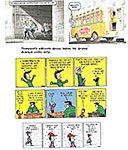


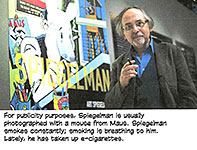
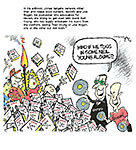

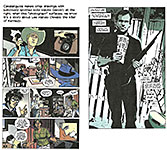
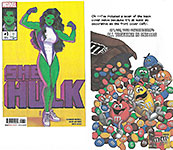
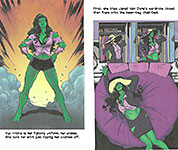
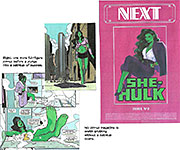
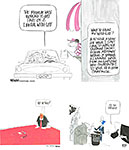
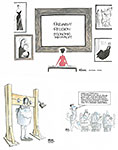
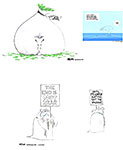
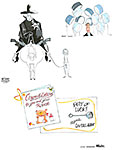

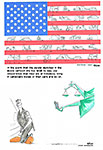


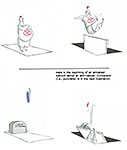


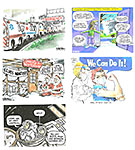
1.jpg)
2.jpg)
3.jpg)
